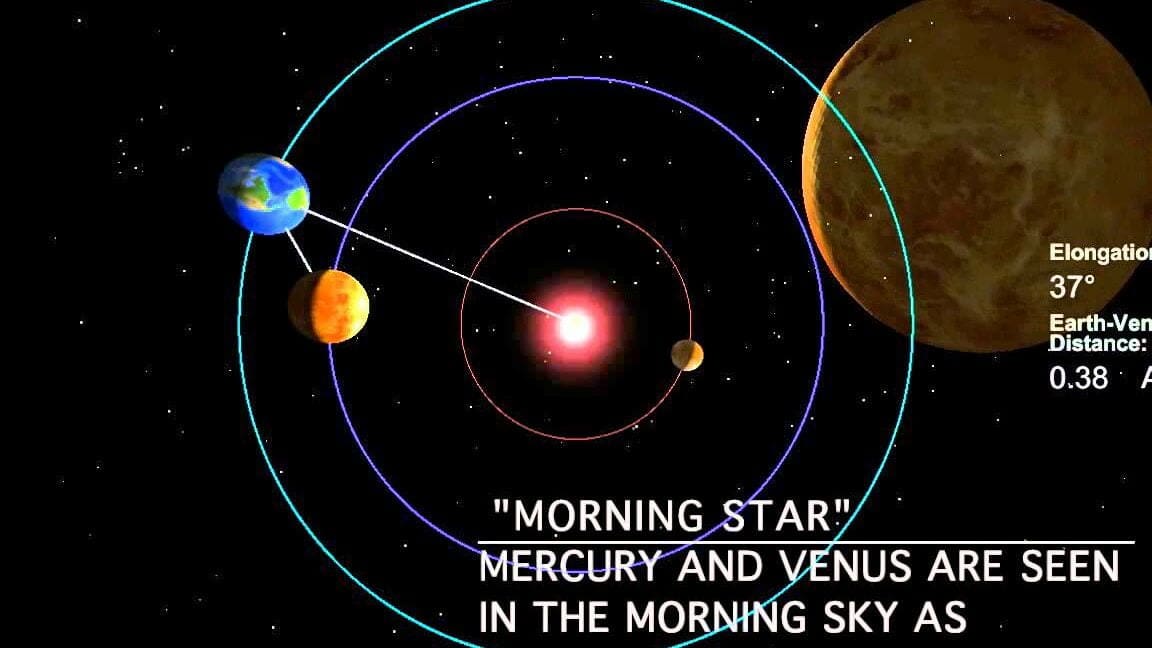
Today we will discuss the characteristics and properties of the planet Venus.
To begin with, Venus is the second closest planet to the Sun, after Mercury. It is also the sixth largest planet in the solar system.
Additionally, Venus is part of the Earth group of planets and is often referred to as the sister planet of Earth due to their many similarities.
It is worth mentioning that Venus was named after the goddess of love in ancient Roman mythology.


Distinguishing Features
Venus shares many similarities in composition, size, and mass with Earth. Scientists estimate its diameter to be 12102 km, giving it a radius of 6051.8 km. However, it has a mass of 4.87*10²⁴ and a density of 5.24 g/cm³, which sets it apart from Earth.
One notable distinction is the length of a Venusian year, which lasts 224.7 Earth days. This is the amount of time it takes for Venus to complete one revolution around the sun.
Additionally, Venus has the longest rotation period among all the planets, with a full revolution taking 243 Earth days. This means that it takes Venus longer to rotate on its axis than any other planet.
Furthermore, the orbit of Venus can be described as nearly circular, with an eccentricity of 0.0067.
According to astronomers, the Sun is positioned approximately 108 million kilometers away (on average), while the distance to Earth can vary between 38 and 261 million km.
This planet possesses a dense atmosphere, primarily composed of carbon dioxide.
As a consequence, the atmospheric pressure at its surface is 92 times higher than that of Earth, causing the outermost layer to exist as a supercritical fluid rather than a gas.
Due to the greenhouse effect, the average surface temperature of this planet reaches a scorching 462 degrees Celsius, making it the hottest planet in our solar system.
Interestingly, it lacks any natural satellites.
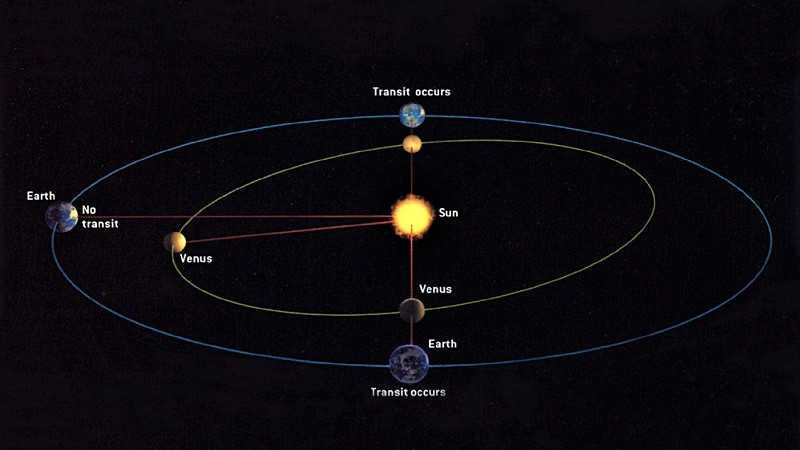
A supercritical fluid is a unique state of matter characterized by temperatures and pressures that exceed the critical point. In this state, the traditional boundaries between gas and liquid phases become indistinguishable, resulting in an intermediate phase.
Surface
The surface of Venus is obscured by clouds of sulfuric acid, making it difficult to see. Interestingly, there is evidence of volcanic activity both in the past and present. This volcanic activity is likely responsible for the presence of sulfur in the planet’s atmosphere.
In contrast, the lithosphere of Venus is highly viscous and lacks any water, rendering it immobile. As a result, there is no plate tectonics occurring on the surface.
Surprisingly, there are relatively few craters on Venus, indicating that the surface is relatively young. Scientists estimate that it formed approximately 500 million years ago. Despite ongoing research, the relief of Venus is not yet fully understood and many questions remain unanswered.
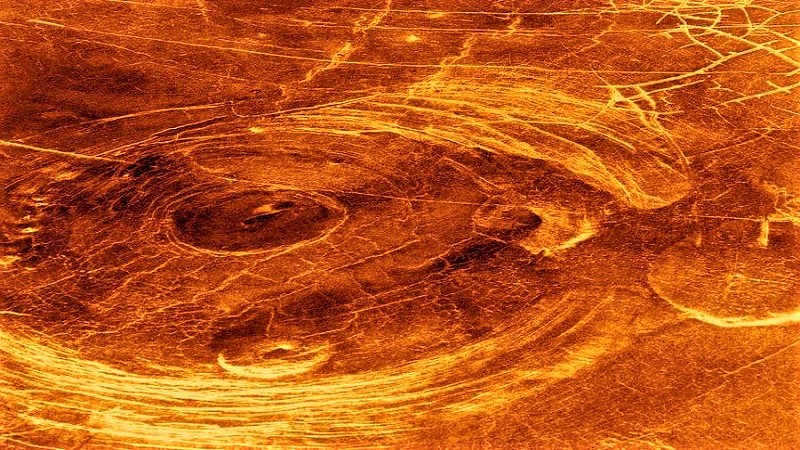
Planet Venus and its fascinating characteristics
As you may be aware, the majority of planets and celestial bodies in our solar system rotate in the same direction. However, Venus defies this norm and spins in the opposite direction.
Interestingly, Venus is the third brightest object in the sky, second only to the Moon and the Sun. It has an apparent magnitude of 4.6.
Furthermore, Venus is known as the morning star. This nickname stems from the fact that a bright star appears in the sky every day before sunrise, which, upon closer inspection, is not a star at all, but the planet Venus.
Interestingly, Venus is also visible as the evening star, as it can be seen at sunset every evening. Sometimes, it can even be observed with the naked eye during the daytime.
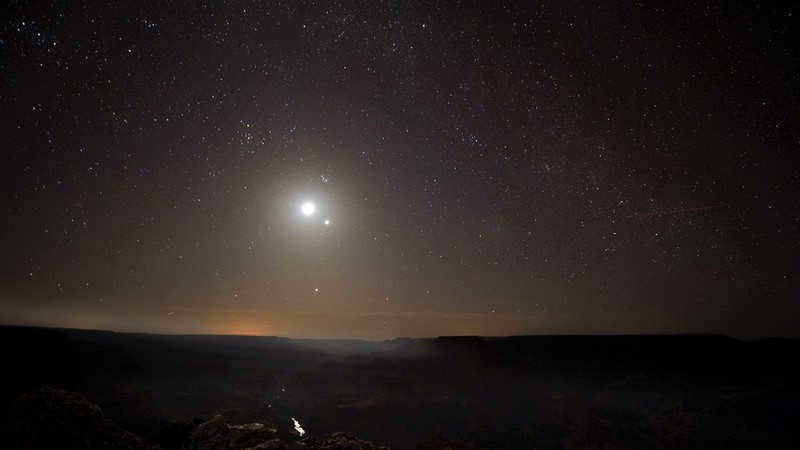
Moreover, it is worth mentioning the hue of Venus. Despite appearing as a pale yellow from our vantage point on Earth, its true color is quite different. In reality, the surface boasts a reddish-brown shade, thanks to the presence of volcanic rocks.
As previously stated, Venus is the second planet in proximity to the sun. Consequently, we have the opportunity to witness its transit across the solar disk from our planet. However, this occurrence is exceedingly rare, happening only four times within a span of 250 years. These transits occur twice in December and twice in June. The most recent event was documented on June 6, 2012, while astronomers predict the next transit will take place on December 11, 2117.
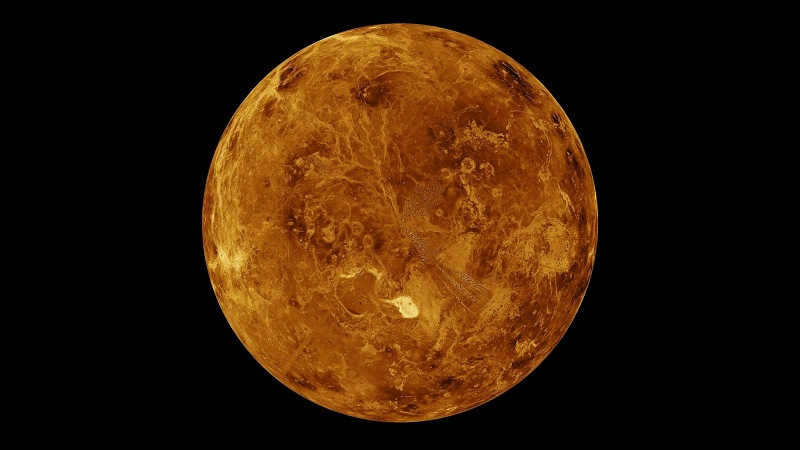
The exploration of Venus was primarily conducted during the 1960-80s. However, due to the challenging conditions on its surface and increased focus on Mars during that period, interest in Venus somewhat waned. Nevertheless, this does not imply that research on Venus has ceased.
Currently, scientists are developing plans for dedicated spacecraft missions to Venus. It is highly likely that in the future, we will gain valuable and fascinating insights into our planet’s “sister”.
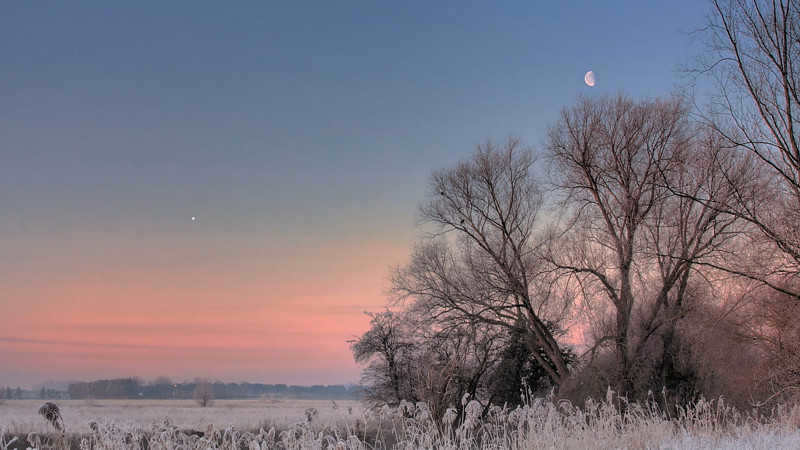
Only a short while ago, Venus, also known as the “evening star,” was illuminating the sky during sunset. However, it has now transitioned to the morning sky and serves as a precursor to the upcoming sunrise. It appears slightly earlier each day, gradually lengthening the time difference between its appearance and the rising sun. As we progress into January and February, Venus will become the most prominent celestial body in the relatively dim pre-dawn skies.
The period of visibility for Venus in the morning has commenced and will continue until the conclusion of summer. The initial stage of this period will offer favorable conditions for observation, although overall the visibility of Venus during this time can be considered satisfactory rather than excellent. As we approach April, the duration of visibility for the “morning star” will notably diminish, but it can still be observed to some extent in the southern latitudes of the northern hemisphere. However, for observers in Moscow and the surrounding areas, it will be challenging to locate Venus in the bright morning or afternoon sky from mid-spring until its upper conjunction in October. Even those with an interest in astronomy will likely struggle to spot the planet during this period.
However, as previously mentioned, we have ample time – at least until the arrival of spring – to marvel at Earth’s most brilliant and exquisite celestial body.

Let me address the most common questions in advance
1
Even though Venus is commonly known as the “evening star” or “morning star,” it is not a star but rather a planet. It shares many physical characteristics with Earth. Venus is just slightly smaller than Earth, by a few percent, and it is approximately 30 percent closer to the sun. The planet is surrounded by a dense atmosphere that makes it difficult to observe its surface directly. Before space missions to Venus, scientists had no idea what its thick clouds were hiding.
However, I have a separate article that delves into what is actually happening on the surface of Venus.
3
Venus can be observed either in the evening or in the morning. However, it becomes invisible when it is positioned behind or in front of the Sun. Nevertheless, there are rare and brief periods when Venus becomes visible for a very short duration (just a few minutes) in both the morning and evening of the same day. This extraordinary occurrence is referred to as the double visibility of Venus. Recently, from January 6 to January 10 of this year, under ideal weather conditions and with a completely unobstructed horizon in the southeast and southwest directions, Venus could be observed both in the morning and evening. Nevertheless, it is important to note that the visibility of the planet during this phenomenon is extremely limited – only a few minutes before sunrise and after sunset.
4
It is worth noting that the transition from Venus being visible in the evening sky to being visible in the morning sky is always relatively short. This time, the planet seamlessly moved from the evening sky to the morning sky. However, once the period of morning visibility ends, it will take some time for Venus to reappear in the evening skies. This is always the case. During this time, Venus does not have a “double visibility” as it hides behind the Sun, gradually overtaking its movement along the ecliptic.
Well, and now let's proceed to the examination of the circumstances and particulars of the morning visibility of the planet Venus in 2022
On the morning of January 10, Venus can be found in the constellation of Sagittarius. However, it is worth noting that Sagittarius itself won’t be visible, as the Sun is located in the same constellation. Nevertheless, Venus, being the most luminous celestial body, manages to rise above the horizon a few minutes prior to sunrise.
However, in the following days, Venus quickly distances itself from the Sun, traveling along the ecliptic in a lateral direction – contrary to the movement of all other planets. The planets exhibit a staggered movement, tracing what astronomers in the Middle Ages referred to as loops in the celestial sphere. These loops prompted the introduction of deferents and epicycles, which were later discarded during the time of Galileo and Kepler. Nevertheless, the origins of these loops remain a mystery to many individuals today.
Loops are not real. They are an optical illusion that occurs when one planet passes another planet while they are in close proximity. Currently, Venus is the closest planet to Earth. As it moves between the Earth and the Sun, it appears to be moving in the opposite direction to the Sun’s apparent motion through the zodiac constellations. However, all of these movements are just illusions because we are observing them from the rapidly orbiting Earth. It is actually the Earth that is moving around the Sun, not the Sun moving among the stars. This alone can be confusing, but when we add the motion of Venus in its neighboring orbit overtaking the Earth, it becomes even more disorienting.
However, let’s focus on how the visibility of Venus has changed since January 10th over the past three months.
You don’t have to be an expert to realize that the optimal conditions for observing Venus occur in the first half of February. As time goes on, the planet we observe gradually moves farther away from the Sun, causing its position above the horizon to decrease and its rising to become less noticeable.
By the end of the animation, specifically in the first half of April, you will be able to spot four planets in the morning sky – Venus, Mars, Saturn, and Jupiter. In 2022, we can anticipate another planetary alignment. But let’s discuss everything step by step.
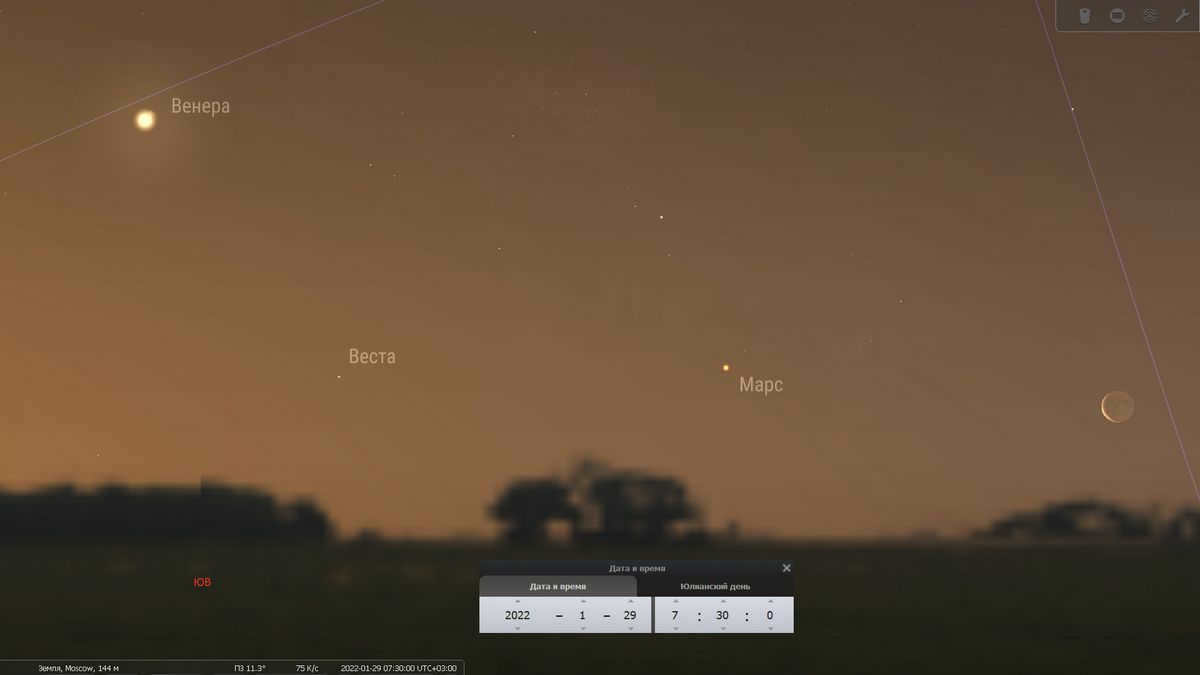
January 29, 2022. The Moon will be close to Mars and Venus
January 2022
Along with Venus, Mars is also visible in the morning sky in January. Mars has been visible in the morning sky since November and is now far behind the Sun. On average, Mars moves 2 times slower on the ecliptic.
Venus is moving towards Mars in the neighboring constellation of Serpentine. On January 21, Mars and Venus will be in the same constellation, Sagittarius. On January 29 and 30, the thin crescent of the old Moon will be visible near both planets.
Incidentally, Venus will also be in a crescent phase during these days, unlike the Moon, Venus’ phase will be increasing. However, the apparent size of the planet (when observed through a telescope) will decrease each day.
It is worth mentioning that asteroid number 4 – Vesta – will be slowly moving between Venus and Mars. Vesta is the brightest asteroid among all the asteroids in the main asteroid belt. It has a size of only about 500 kilometers, but during favorable visibility periods, Vesta can reach a magnitude of 5 stars and can be relatively easily observed without any optical aids. However, given that we are currently facing the morning dawn – towards the Sun – Vesta is on the opposite side of the Sun, which means it is very far away, even farther than Mars. It will not be visible to the naked eye in early 2022. But with the help of light optics, it can be observed, as Vesta is currently brighter than a magnitude of 8 stars.
February 2022
On February 13, Venus and Mars are set to achieve conjunction, a term used in astronomy to describe when both celestial bodies have the same direct ascension coordinate. In the sky, they will be approximately 7 degrees apart, with Venus positioned to the north or “higher” than Mars. However, in the vastness of outer space, these planets will be separated by hundreds of millions of kilometers. From the perspective of an observer on Earth, both Venus and Mars will appear to be in close proximity. During this time, the distance from Earth to Venus will be around 62 million kilometers, while the distance to Mars will be approximately 313 million kilometers. Vesta, which lies between the two, will be even farther away at a distance of 428 million kilometers.
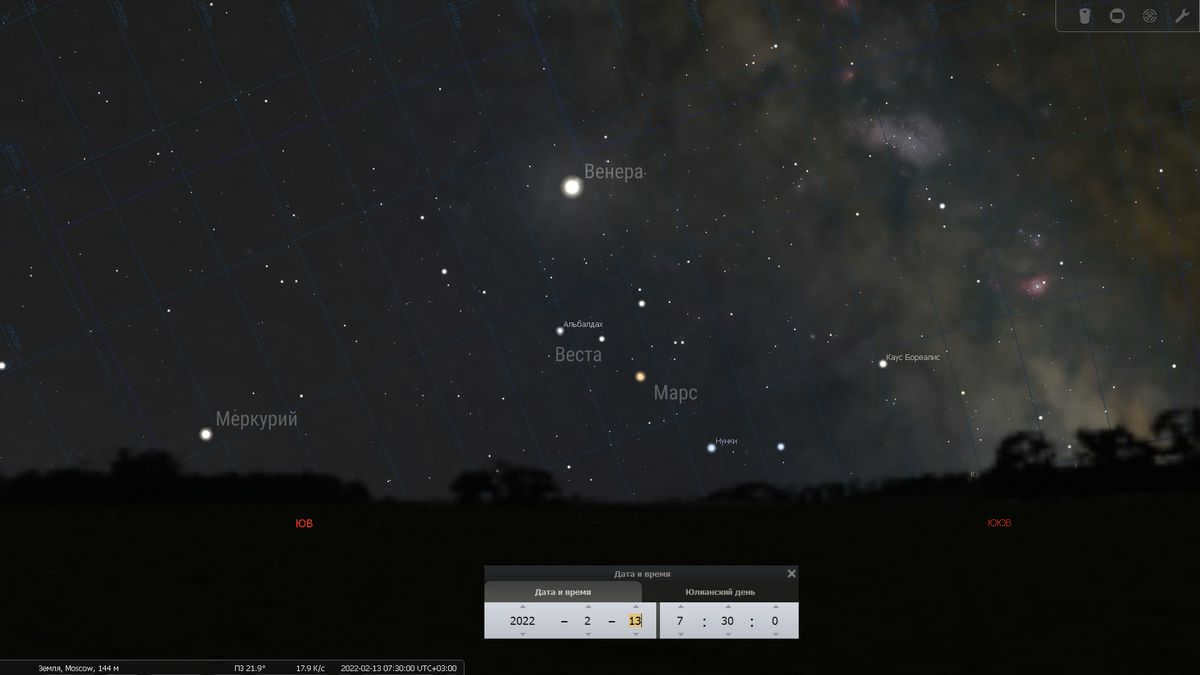
On February 13, 2022, there will be a special event in the sky – the conjunction of Venus and Mars. Venus will be positioned in a stationary position, creating a unique celestial display.
In addition to this spectacular event, Mercury will also make an appearance to the east of these two planets. However, its visibility will be limited as it rises above the horizon later than Venus and Mars.
This conjunction between Venus and Mars will continue, providing an ongoing celestial show for sky gazers. It’s truly a remarkable sight to behold!
Let’s imagine a scenario where the morning sunrise doesn’t obstruct the faint stars and the day speeds up to half a second.
As we can observe, as Venus approaches a standstill, it gradually slows down and then gradually picks up speed again. During this time, Venus will have a similar speed along the ecliptic as Mars, which was in close proximity during the standstill days. Consequently, Venus and Mars will be inseparable for almost the entire month of February. They will move in sync, first through the constellation of Sagittarius and then through the constellation of Capricorn.
On February 27, 2022, the waning Moon will be in close proximity to both Venus and Mars.
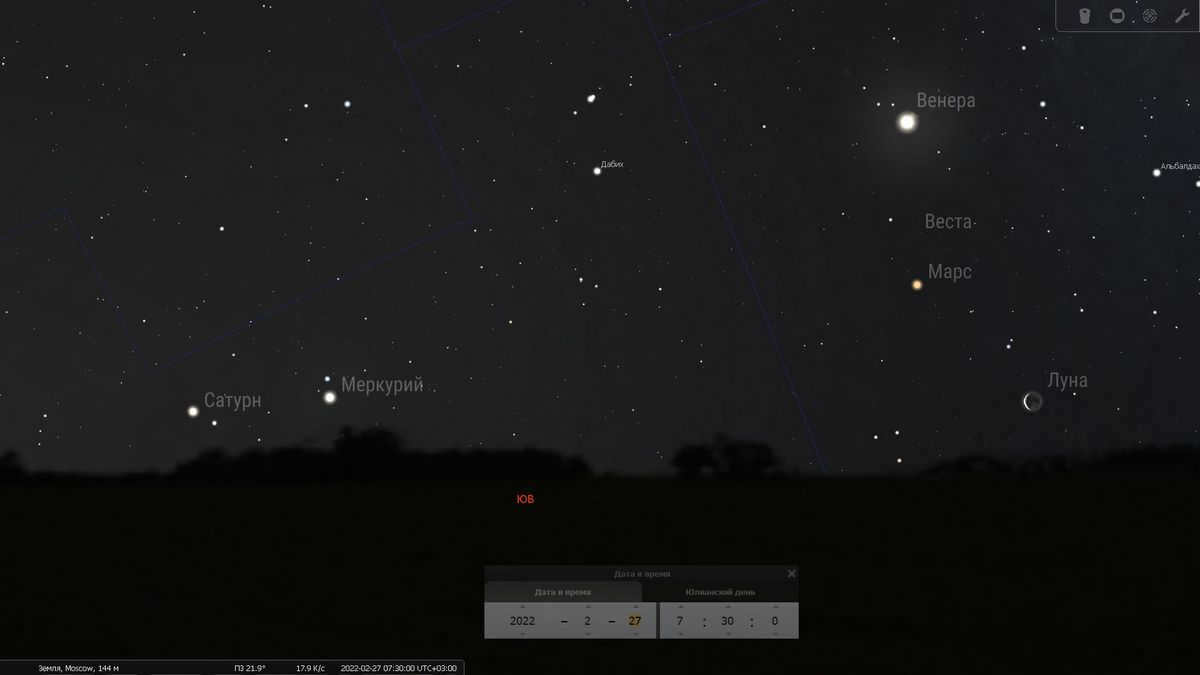
February 27, 2022. The Moon will be situated close to both Venus and Mars.
March 2022
On March 2 and 3, Mercury and Saturn will come close to each other in the sky, appearing to pass by one another. Unfortunately, observing this “conjunction” will be challenging due to their low position above the horizon. However, in regions with more southerly latitudes, it may be possible to view this event without strong optical equipment.
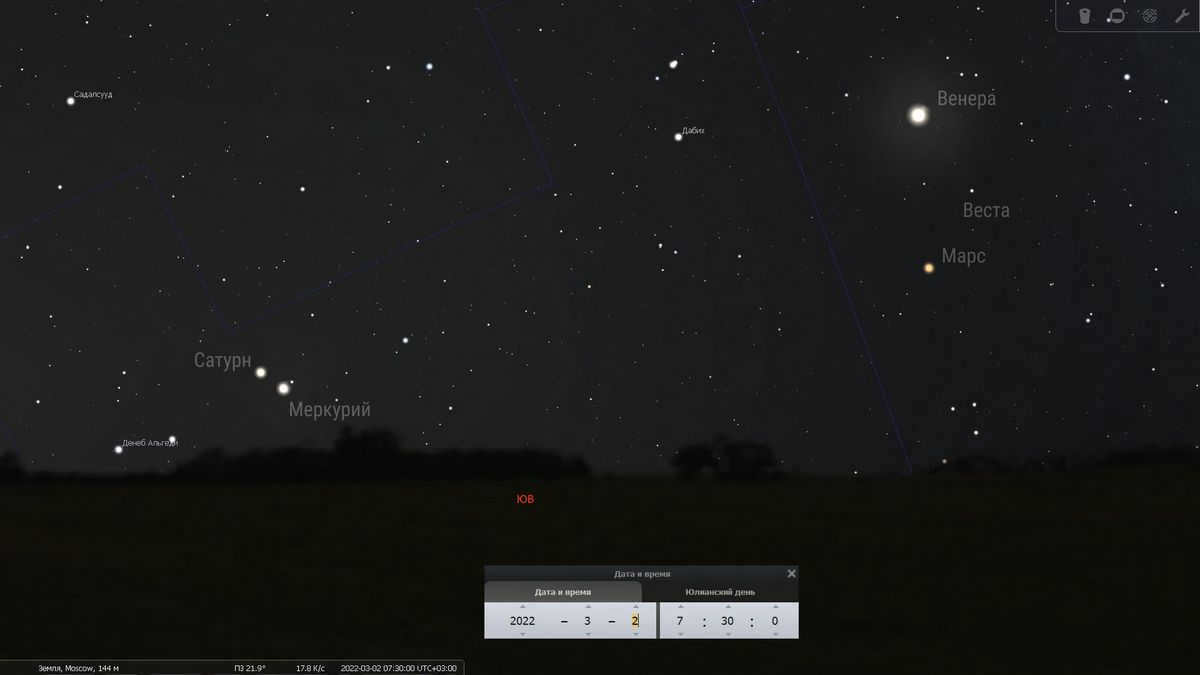
March 2, 2022. The conjunction of Mercury and Saturn
March 11 will see Venus coming into close proximity with two prominent stars, alpha and beta Capricorn. These stars are particularly fascinating as they are visually stunning and can be easily observed by amateur astronomers due to their double (multiple) system nature.
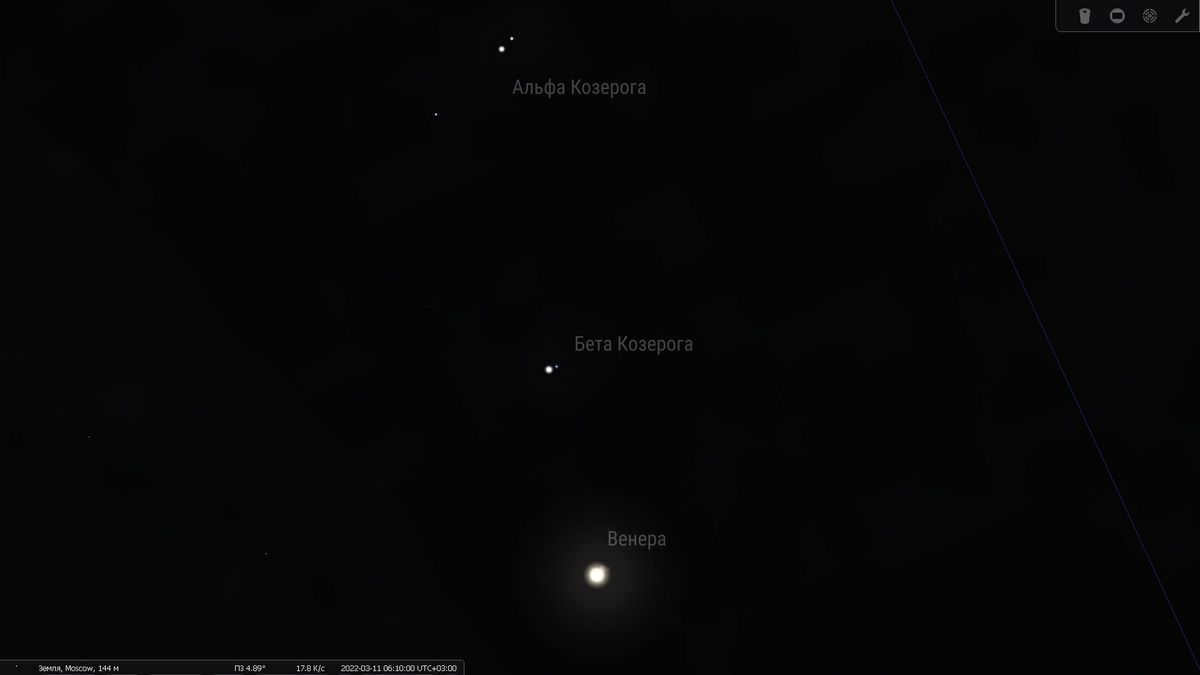
March 11th, 2022. Venus in close proximity to alpha and beta Capricorn
On the 20th of March – during the vernal equinox – Venus will achieve its maximum westerly elongation, reaching a distance of 46 degrees from the Sun. Following that day, the planet will gradually move closer to the Sun in the sky.
The final ten days of March and the initial ten days of April can be characterized as a period of simultaneous visibility of three prominent planets – Venus, Mars, and Saturn. Venus and Mars, being the faster-moving planets, will catch up to the slower-moving Saturn as they traverse through the Capricorn constellation. For a time, all three planets will be situated near the border of Capricorn and Aquarius, forming a compact cluster.
March 28 will see the addition of the Moon to this group, although its visibility will be limited due to its low position above the horizon in mid-latitudes.
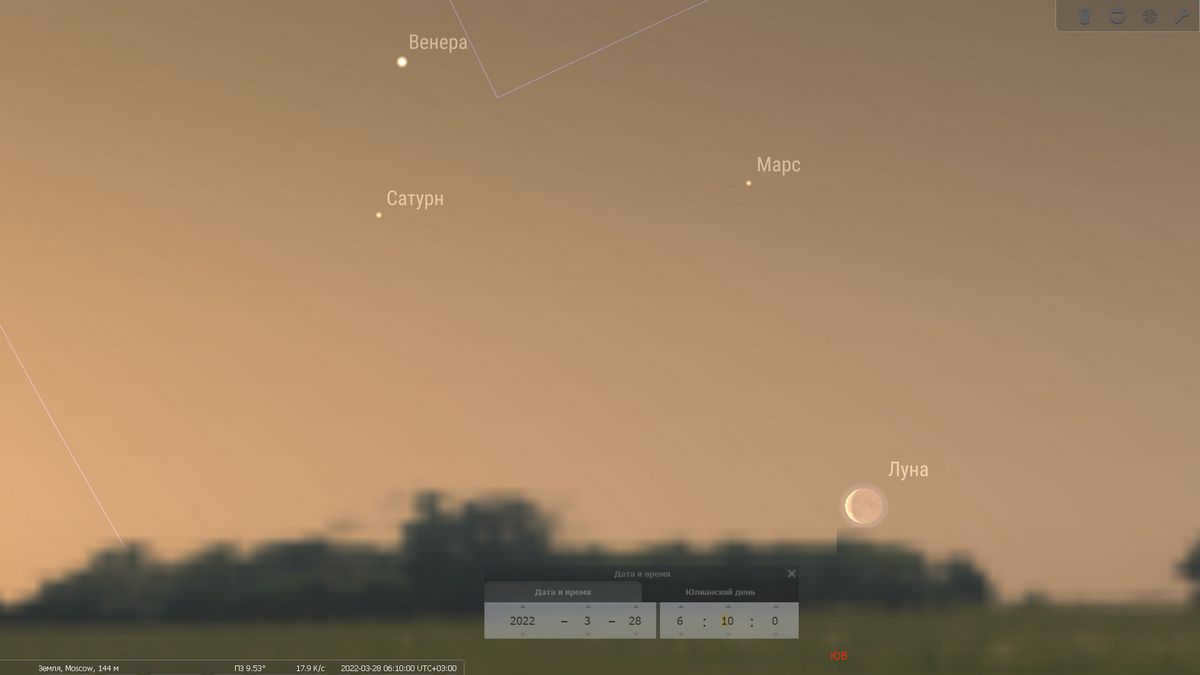
March 28, 2022. The Moon will be in close proximity to Venus, Mars, and Saturn.
April 2022
On April 2, Venus, Saturn, and Mars will align in a straight formation near two other prominent stars at the far end of the Capricorn constellation – delta and gamma. Subsequently, Venus, which has been steadily gaining momentum, will separate from this group and proceed with its swift trajectory, venturing into the Aquarius constellation on its own.
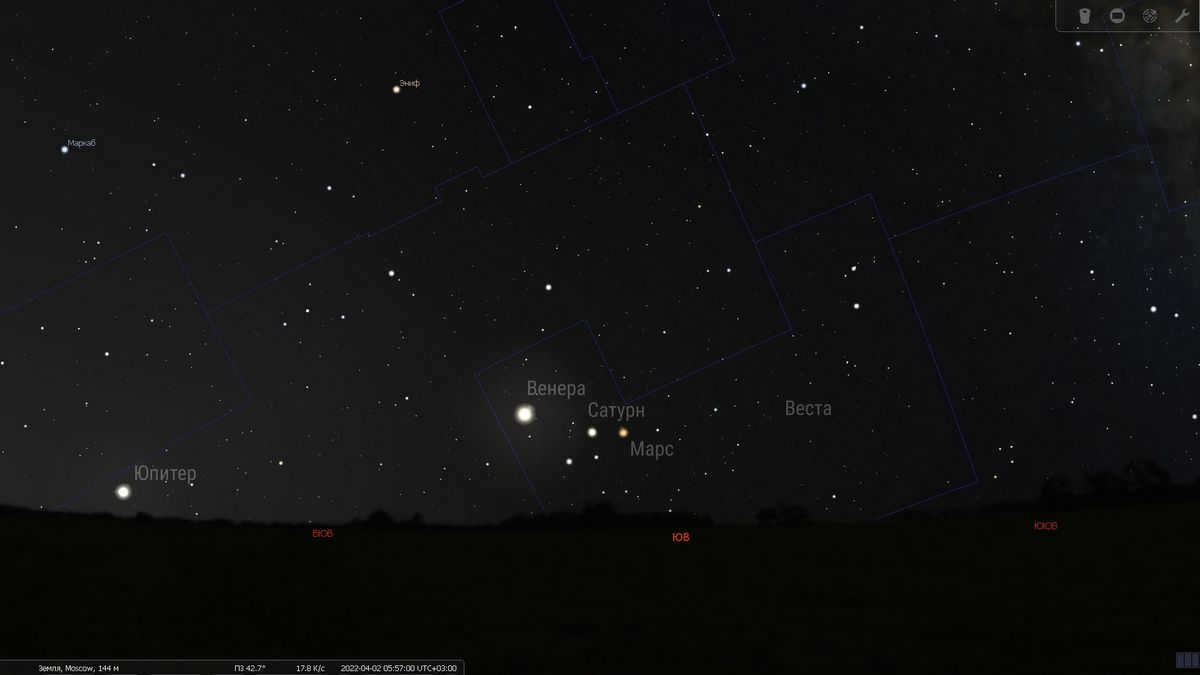
On April 2nd, the planets Venus, Saturn, and Mars will be in close proximity to the delta and gamma stars of the Capricorn constellation.
While our focus is mainly on Venus, it’s important to mention that just three days later on April 5th, Mars and Saturn will come even closer together. In fact, they will be so close that they can be observed in the same telescope field of view at a relatively high magnification. This will provide us with the opportunity to see Saturn’s magnificent rings and its orbiting moons.
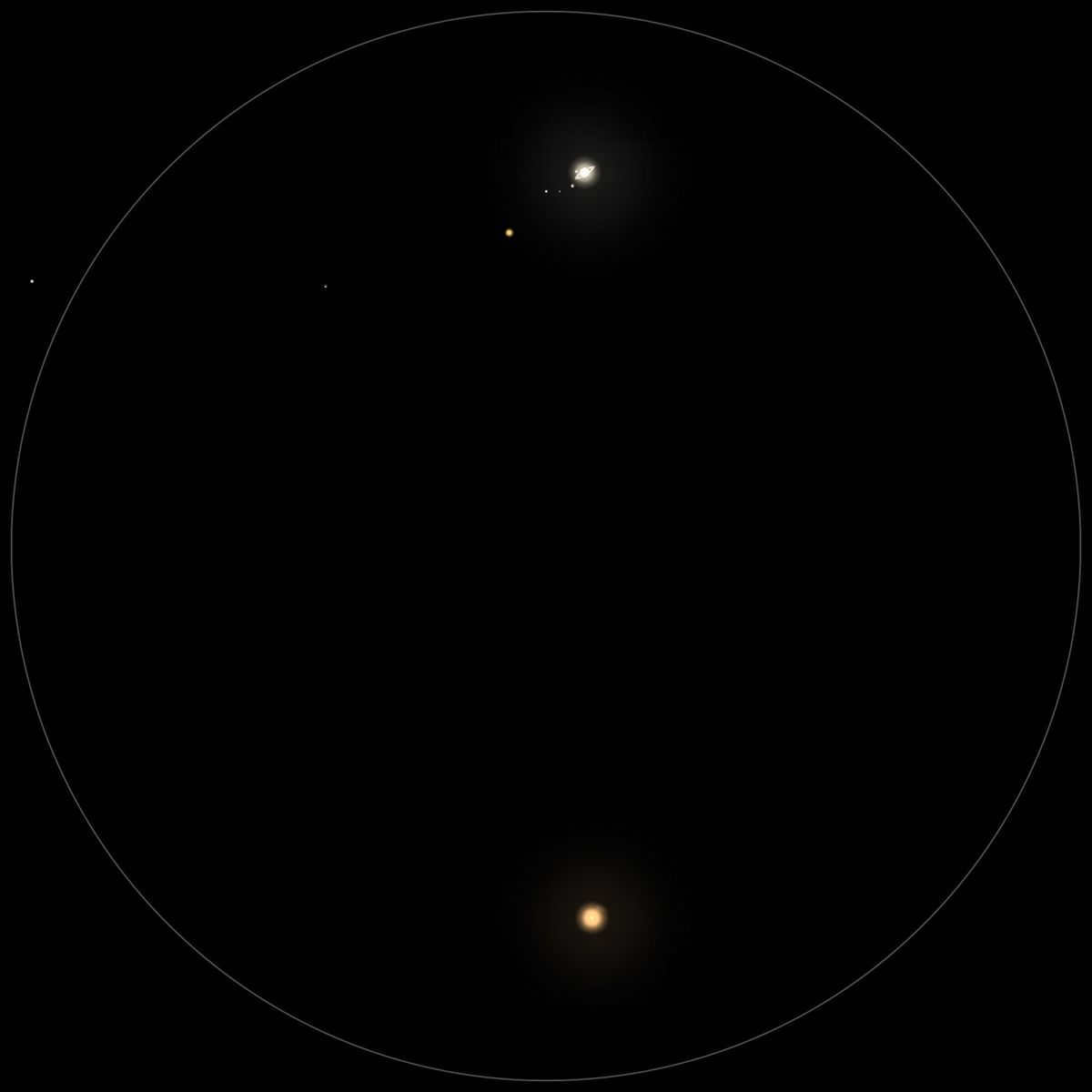
On April 5, 2022, there will be a conjunction between Mars and Saturn. This celestial event can be observed through a telescope.
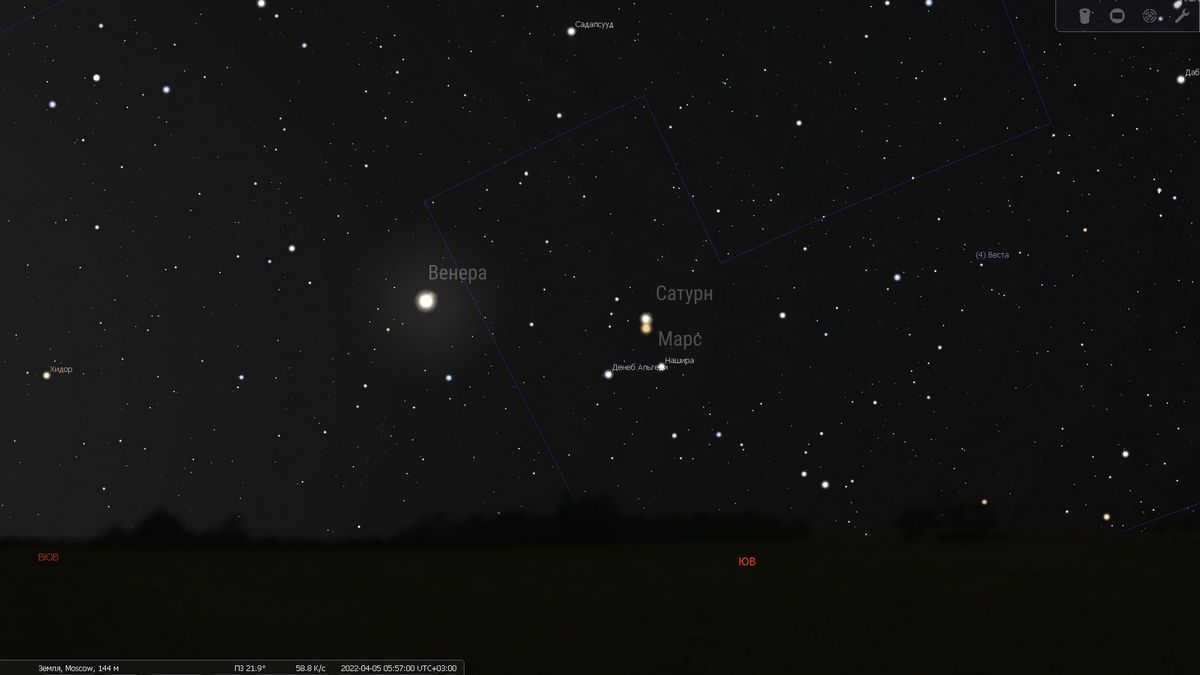
On April 5, 2022, there will be a conjunction between Mars and Saturn. This event can be observed in the sky without the Sun’s light interfering.
By the beginning of April, the visibility of the planets mentioned above will no longer be favorable. The earlier sunrise and the low position of the ecliptic along the southeastern horizon will cause the planets to appear faint in the morning light and they will not rise above the horizon in a noticeable way. Due to their extremely low position and short visibility duration, observing them will be very challenging.
Continuing just beyond Saturn, we will find the asteroid Vesta, which has become slightly brighter since the start of our discussion, yet it remains invisible to the naked eye.
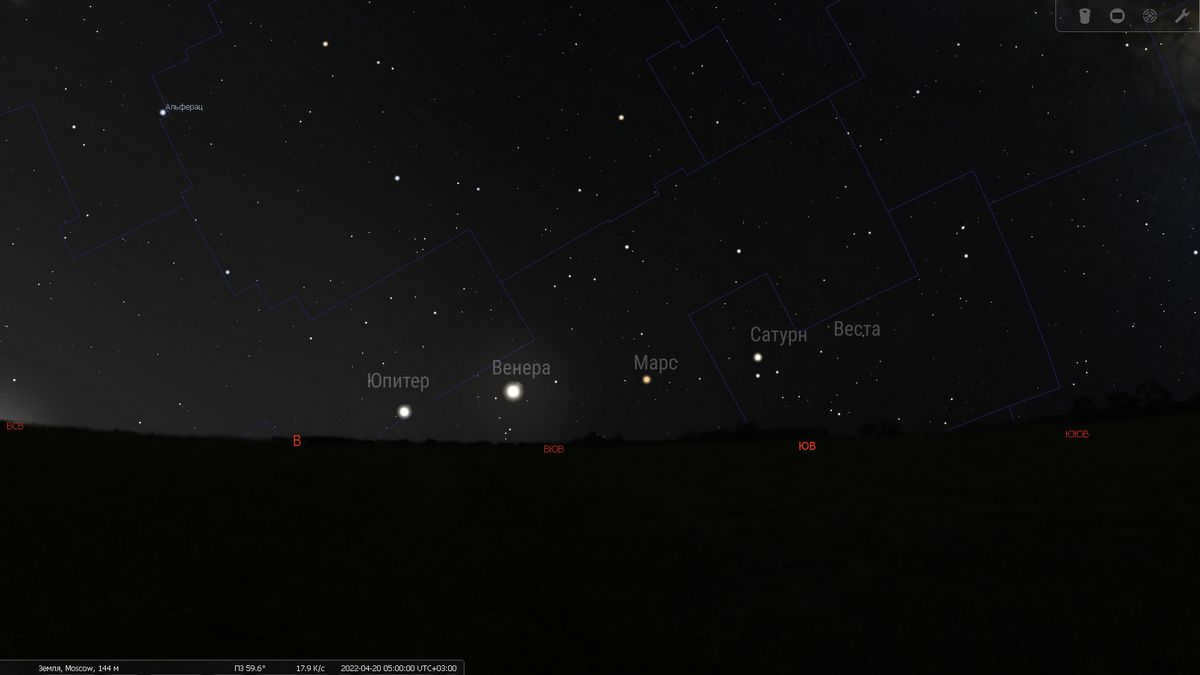
April 20, 2022. The planets Jupiter, Venus, Mars, and Saturn will align in a unique formation, creating what is known as the “Parade of the Planets.” This celestial event will be visible in the morning sky on April 20, 2022.
One interesting aspect to observe during this time is the movement of Venus as it passes by the Chicken Paw asterism, which is formed by the clustered stars Phi, Hi, and Psi (1,2,3) in the constellation of Aquarius. This occurrence is set to happen on April 21-22.
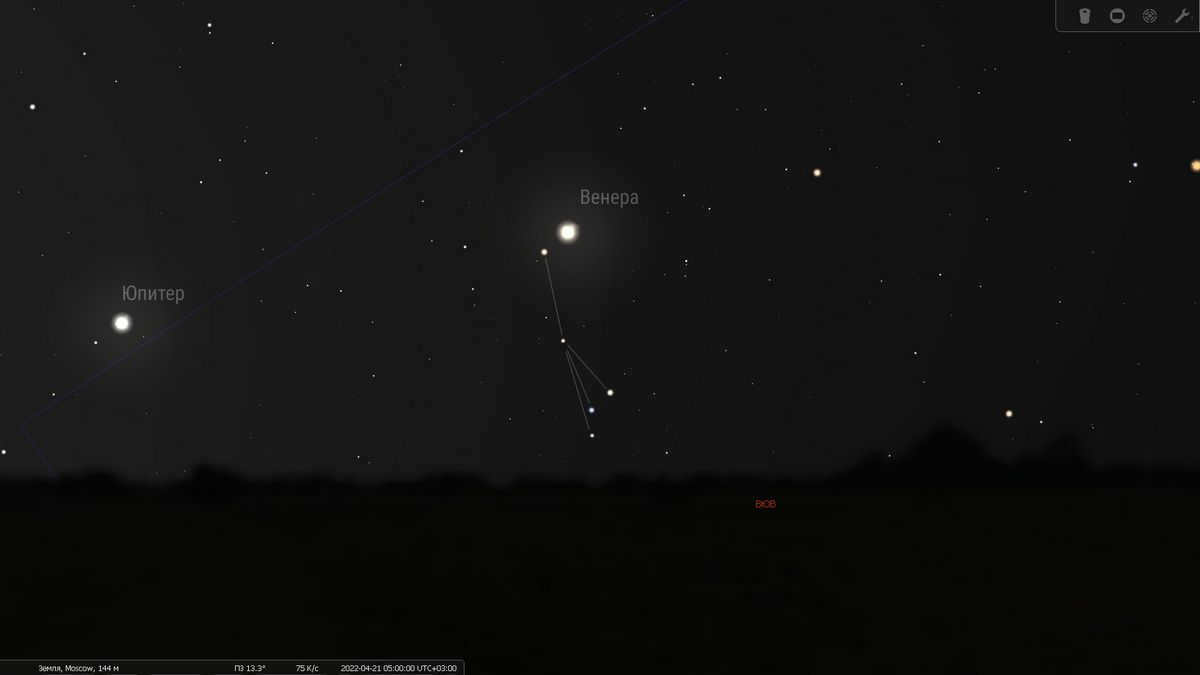
April 21, 2022. The Morning Star is what planet?
During the final days of April, the decreasing Moon will pass by each of the planets one by one. The aging crescent will move well to the south of the imaginary line in the sky followed by the Sun’s path, making it difficult to see in the middle latitudes of the northern hemisphere. However, in the southern latitudes, all four planets and the Moon can be observed to a reasonably good extent.
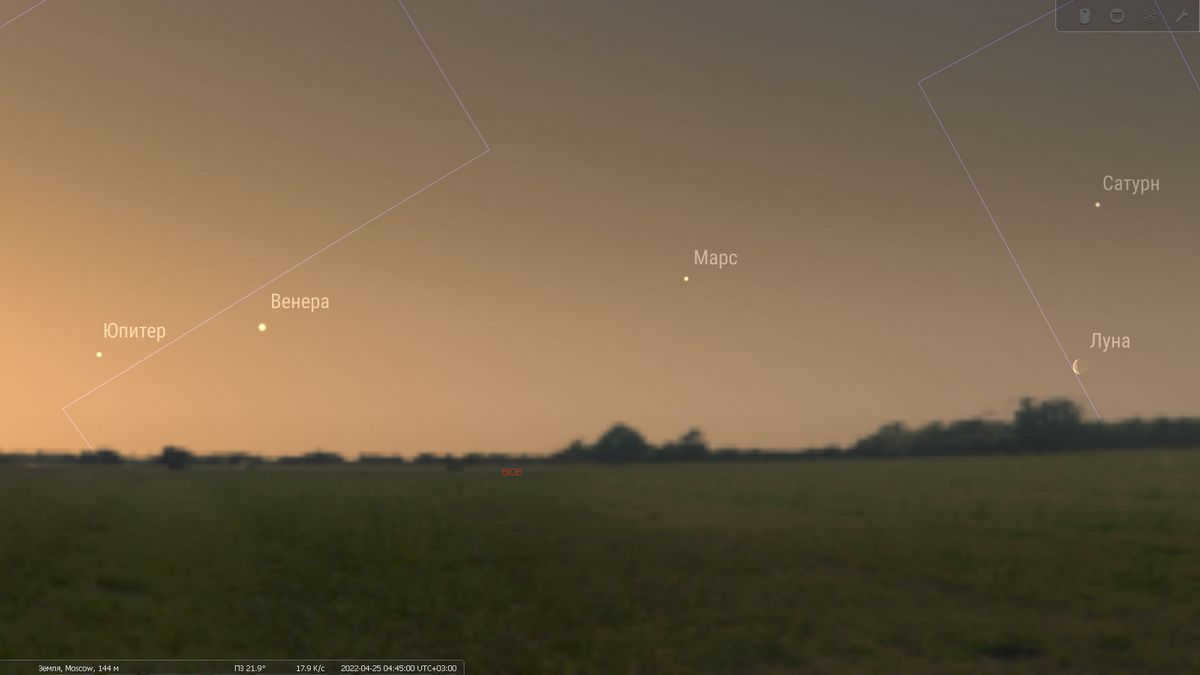
On April 25, 2022, the Moon will be in close proximity to Saturn.
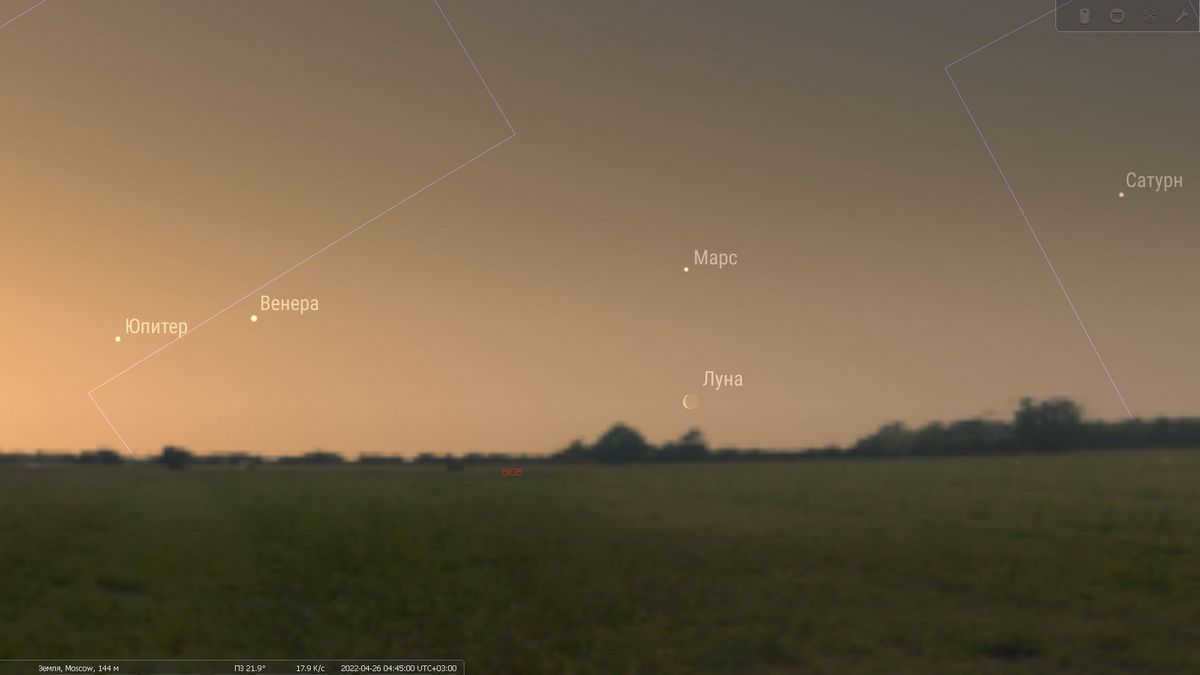
On April 26, 2022, the Moon will be in close proximity to Mars.
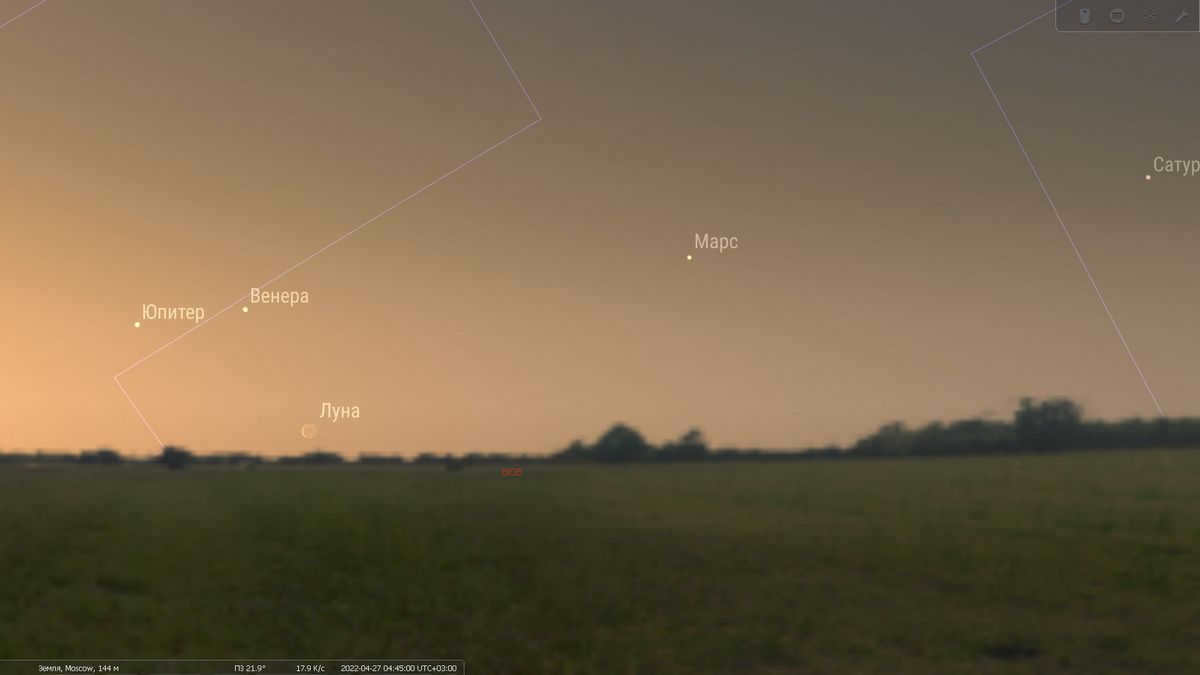
April 27, 2022. The Moon will be in close proximity to Venus and Jupiter
May 2022
On the morning of May 1, there will be a near conjunction between Venus and Jupiter. The angular separation between the two planets will be approximately 15 arc minutes, which is equivalent to half the size of the Moon. To the naked eye, it might appear as if the two bright objects have merged into a single, even brighter entity.
When observed through a telescope at medium magnification, both Venus and Jupiter can be seen in the same field of view. It will also be possible to observe Jupiter’s satellites, including Io, which will be partially obscured by Jupiter during this time.
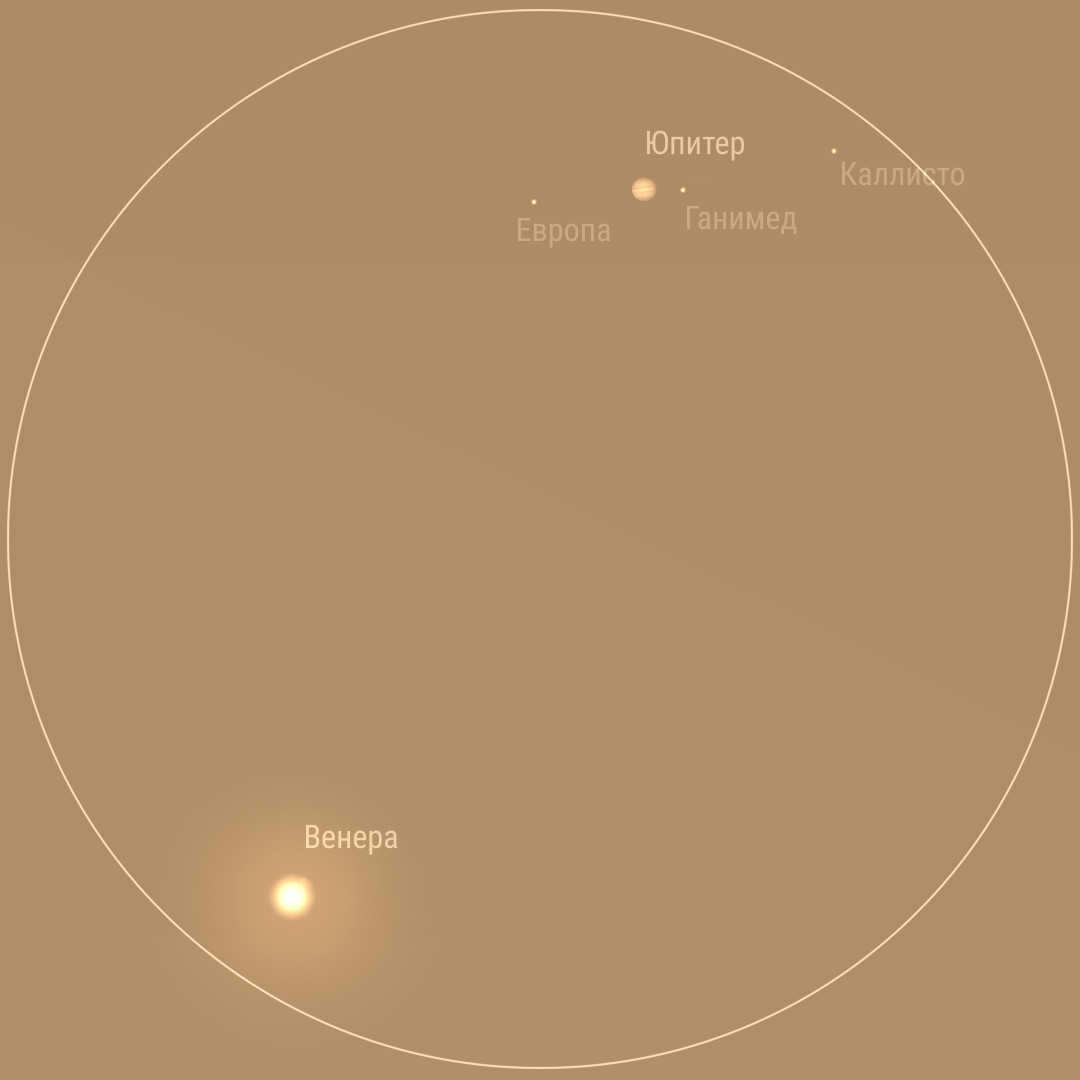
On May 1, 2022, there will be a remarkable event in the night sky – the conjunction of Venus and Jupiter. This celestial phenomenon can be observed through a telescope, providing a unique opportunity for stargazers and astronomers alike.
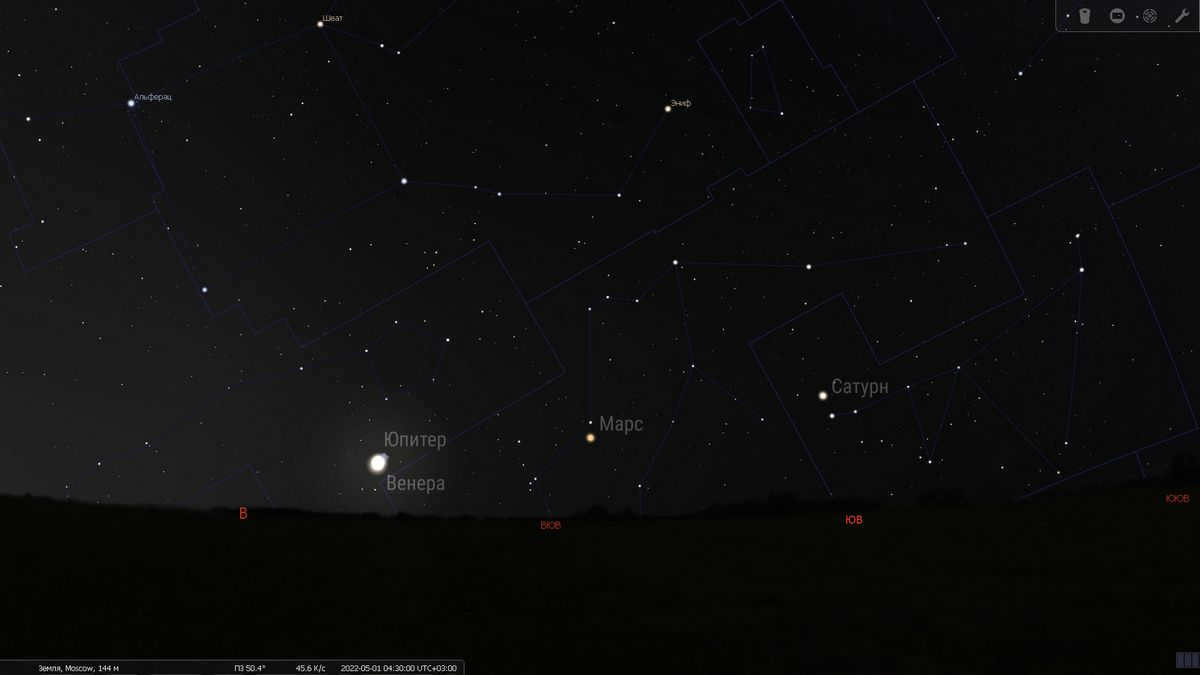
May 1, 2022. Witness the conjunction of Venus and Jupiter, visible to the naked eye. The radiant morning sunlight illuminates the sky as the Sun rises.
On May 12, a remarkable celestial event will take place on the border of the constellations Pisces and Aquarius. Venus, Jupiter, and Mars will once again align in a magnificent formation, forming a chain with equal distances of 10 degrees between each planet. Not too far away, approximately 30 degrees to the west, Saturn will also be visible on the border of the constellations Aquarius and Capricorn. The parade of planets continues, offering a spectacular display in the night sky.

On May 12, 2022, there will be a celestial event worth looking up to. Venus, Jupiter, Mars, and Saturn will be visible in the night sky.
As we enter the third decade of May, the Moon will make its way towards these planets. The first encounter will be with Saturn on May 22. The Moon will pass just 5 degrees south of the ringed planet, creating a stunning celestial spectacle.
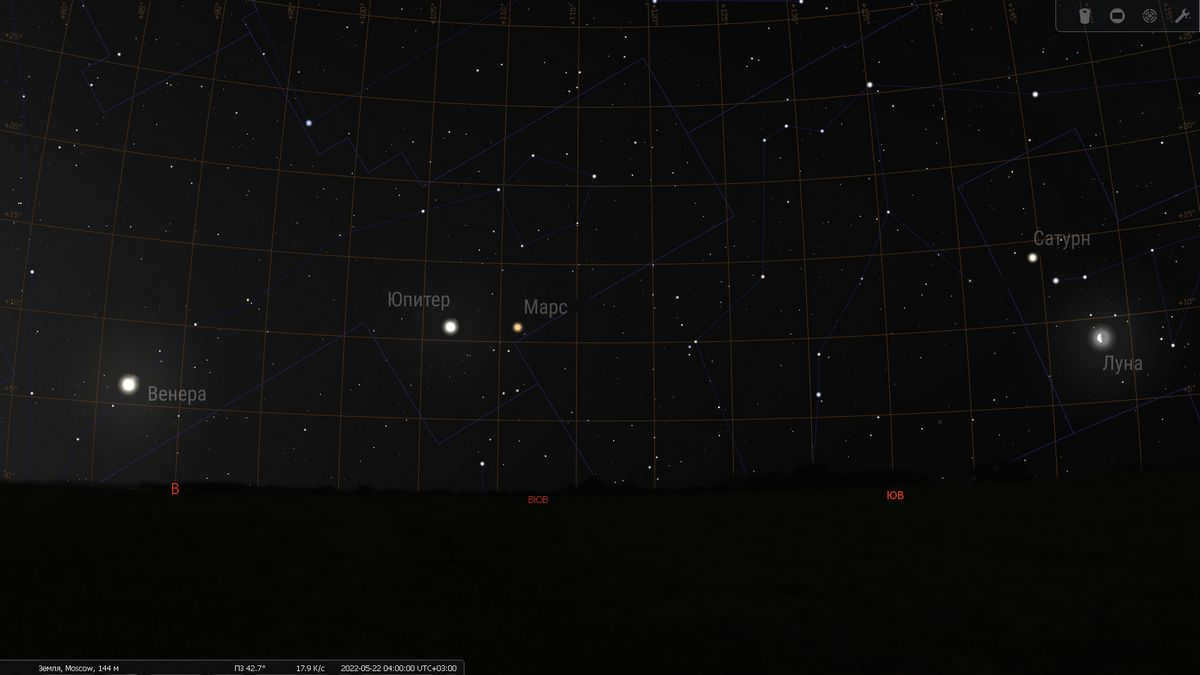
On May 22, 2022, there will be a celestial event where the Moon will be in close proximity to Saturn.
On May 25, the Moon will be positioned 3 degrees south of Jupiter and Mars. This conjunction of the two planets and the Moon is an incredible sight to behold, especially when observed with binoculars or a telescope. With these instruments, you can witness all three celestial bodies fitting perfectly within the field of view.
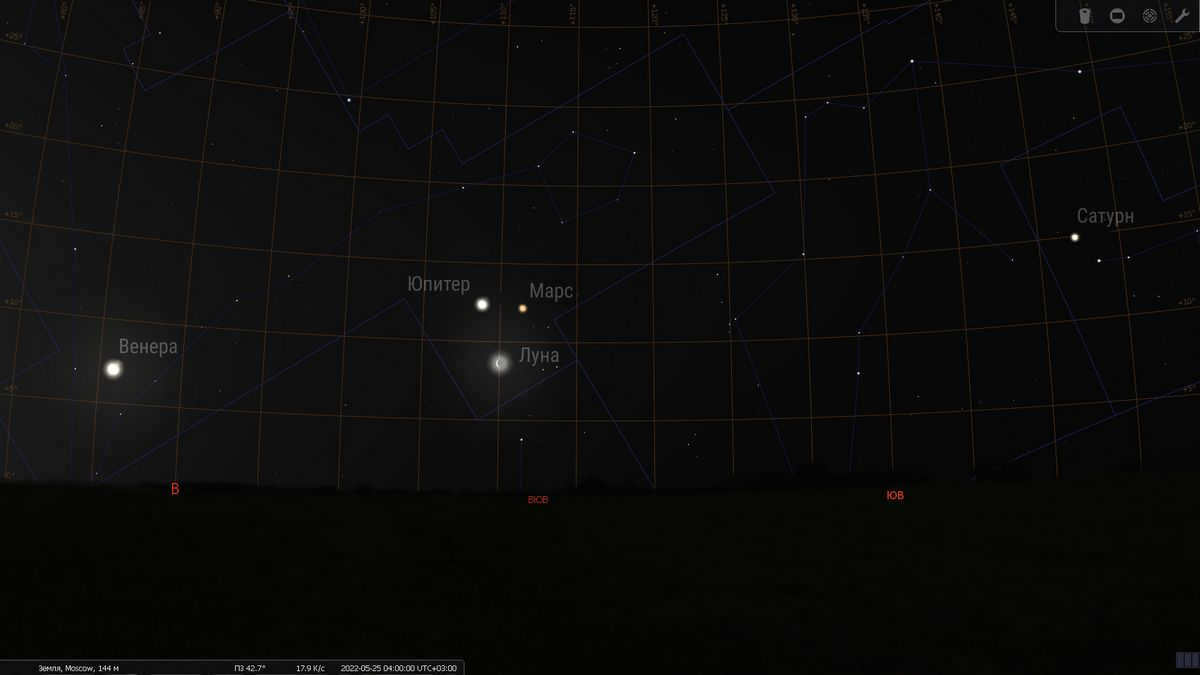
On May 25, 2022, there will be a celestial event where the Moon will be in close proximity to Jupiter and Mars.
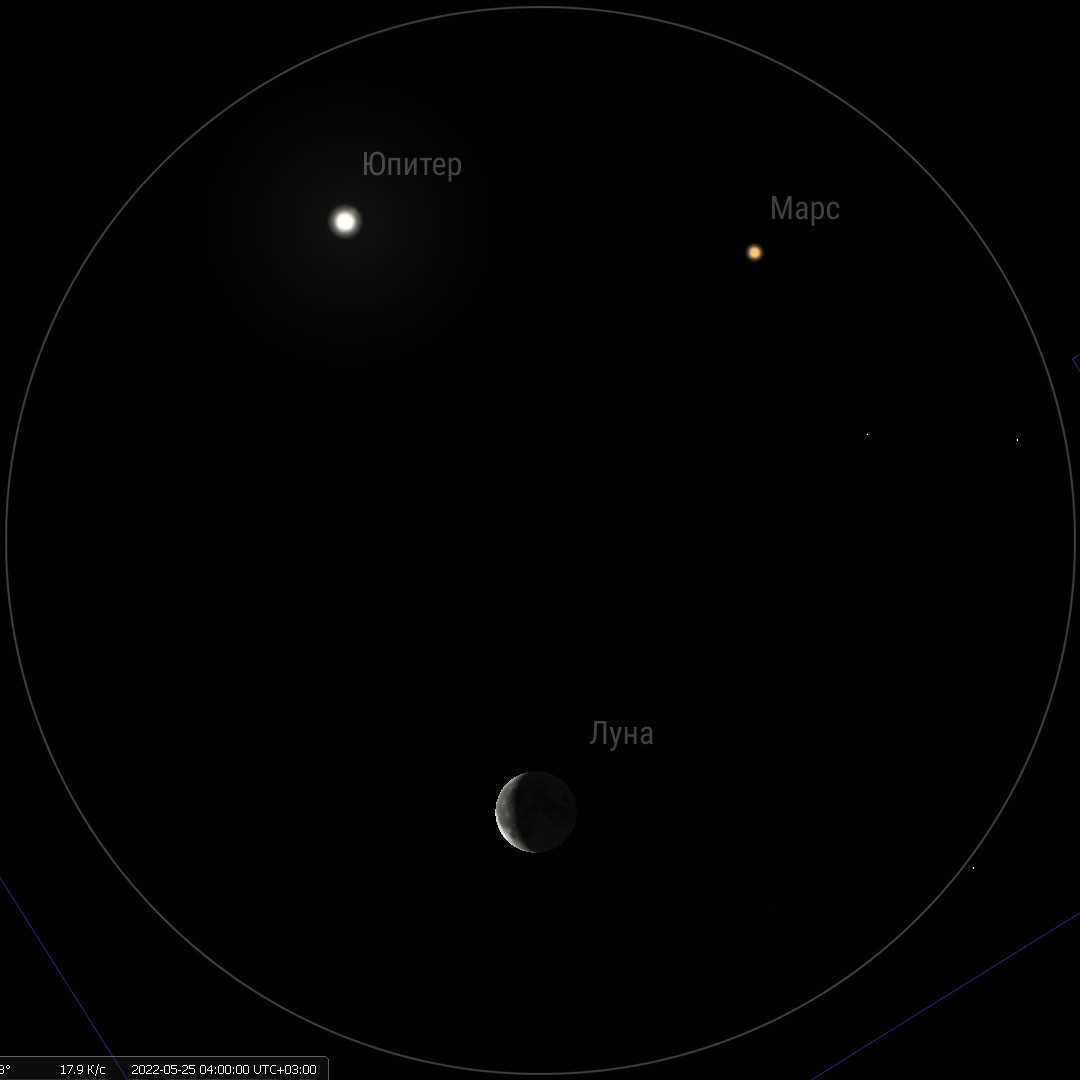
On the 25th of May, 2022, you will be able to observe the Moon near Jupiter and Mars through a telescope.
On the 27th of May, the Moon will have an even closer conjunction with Venus, passing just 1 degree south of the planet. At the same time, Venus itself will pass ⅓ of a degree south of the star Omicron of Pisces.
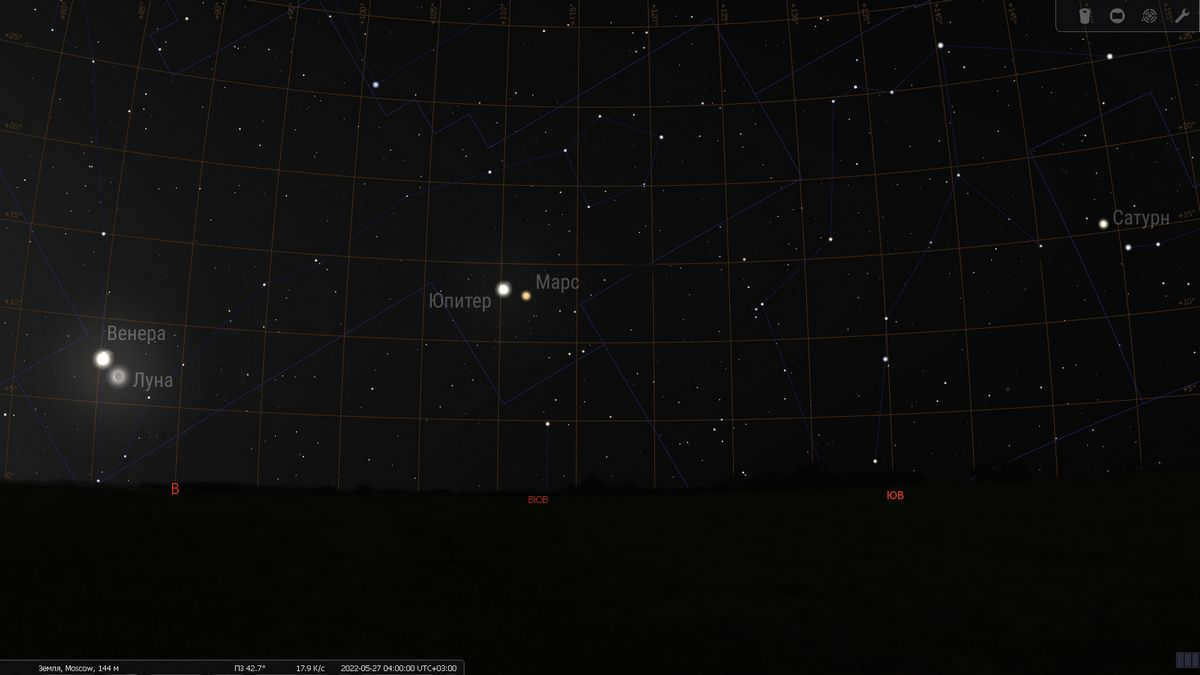
On May 27, 2022, the Moon will be in close proximity to Venus, while Venus will be near the star Omicron in the constellation Pisces.
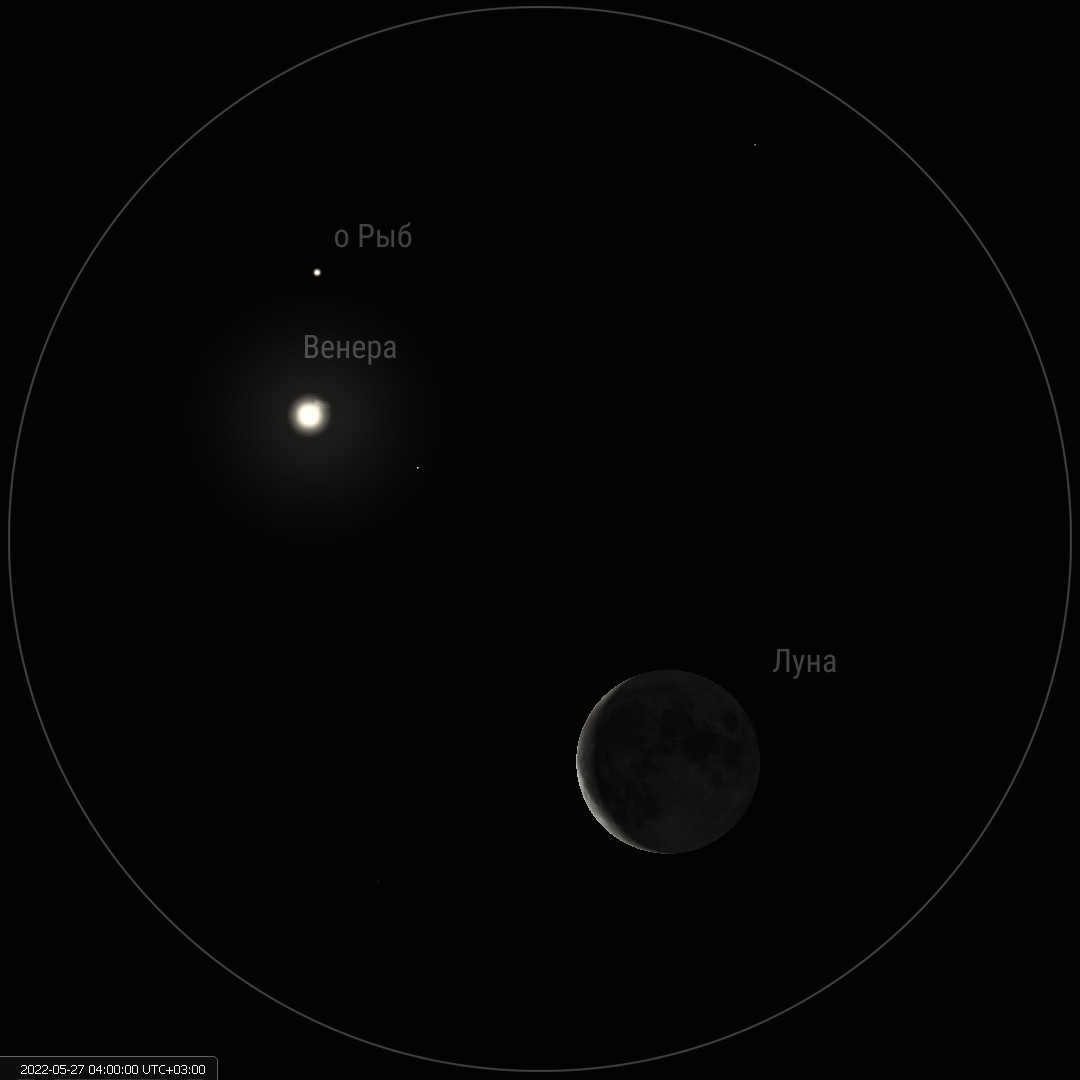
On May 27, 2022, there will be a beautiful celestial event to witness. The Moon will be in close proximity to Venus, while Venus will be near the star Omicron in the constellation Pisces. This event can be observed through a telescope, providing a magnificent view of the night sky.
Furthermore, on May 29 and 30, there will be another fascinating conjunction of planets. Mars will pass just half a degree south of Jupiter, creating a close celestial alignment. This conjunction will be a remarkable sight to behold, especially when observed through a telescope. At low magnification, it will be possible to see Mars, Jupiter, and all four of Jupiter’s Galilean satellites in the same field of view. Don’t miss this incredible opportunity to witness the wonders of the universe!
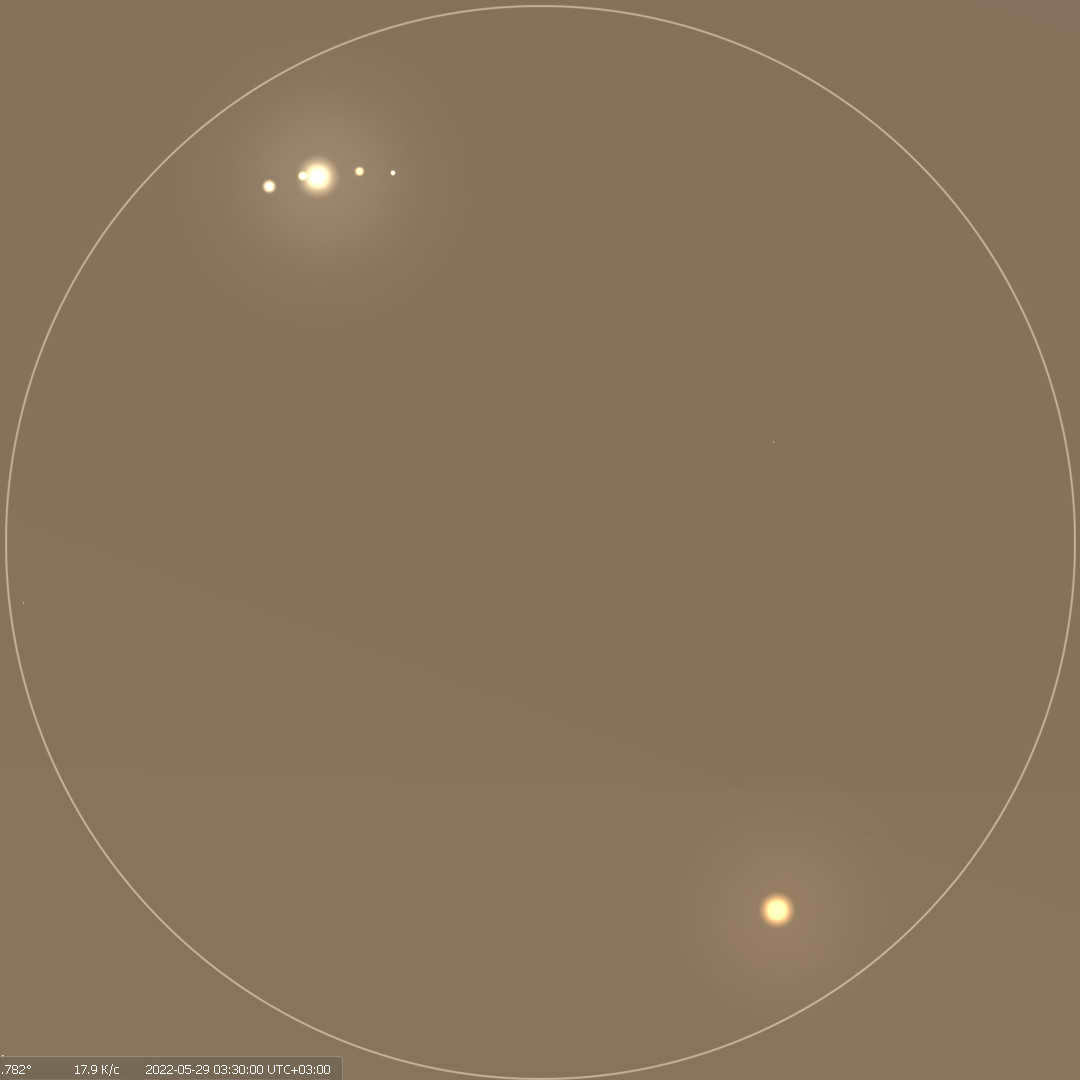
On May 29, 2022, a remarkable event took place – the conjunction of Mars and Jupiter. This celestial phenomenon was observed by astronomers and stargazers alike, who eagerly turned their telescopes towards the night sky. The sight of these two prominent planets aligning in such close proximity was truly awe-inspiring. It served as a reminder of the vastness and beauty of the universe, captivating the hearts and minds of all who witnessed it.
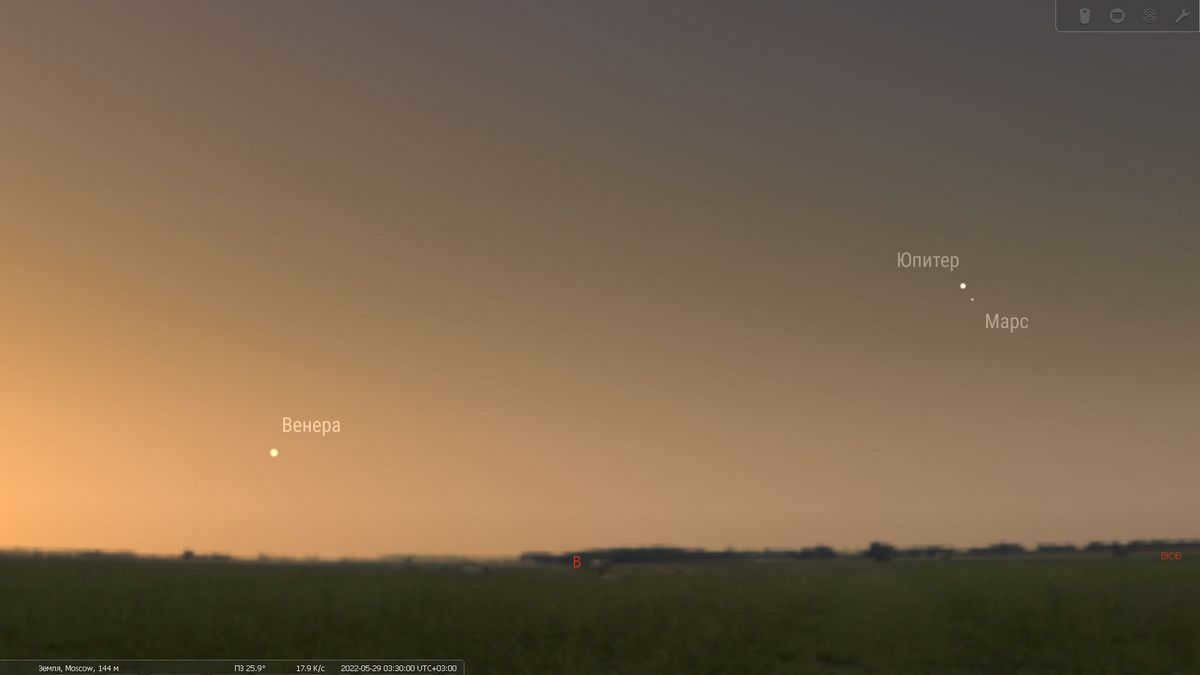
May 29, 2022. The conjunction of Venus and Jupiter with Mars can be observed in the morning sky.
June 2022
Starting from June 1, Venus transitions into Aries, where it will remain for the next 17 days. During this time, it will be visible briefly, appearing low above the horizon in the eastern and northeastern regions.
On June 18, Venus moves into Taurus and begins to gradually approach the Sun, which is also located in the same constellation, but on the opposite side.
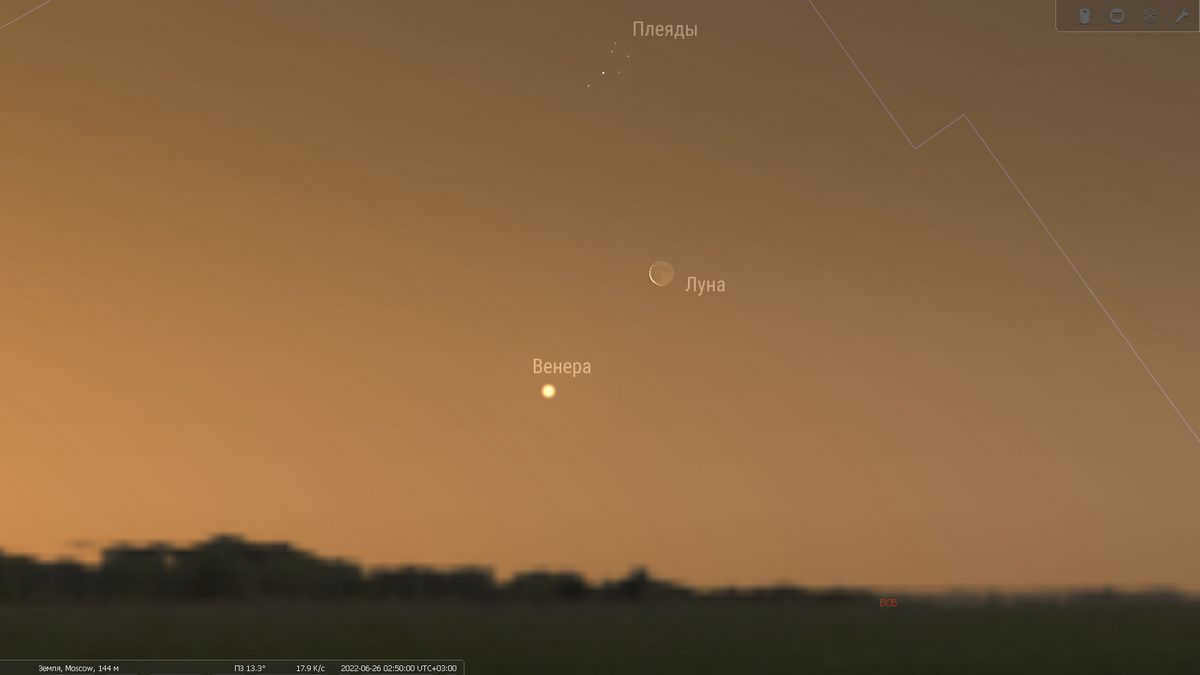
June 26, 2022. The Moon will be in close proximity to Venus and the Pleiades star cluster in the constellation Taurus.
In the early morning hours of June 26, the crescent Moon will pass by Venus and the Pleiades star cluster. This celestial event is expected to be quite stunning, especially if the atmospheric conditions are ideal and there is an unobstructed view of the northeastern horizon. The Moon and Venus will be visible at a relatively low altitude of about five degrees.
July 2022
During the period from June 29 to July 2, Venus is expected to move a few degrees north of the dispersed star cluster Hyades and 5 degrees north of Aldebaran, the most prominent star in the Taurus constellation. However, it is unlikely to be visible in the middle latitudes of the northern hemisphere. Moreover, the visibility of Venus in the morning sky in the northern hemisphere of the Earth is gradually coming to an end.
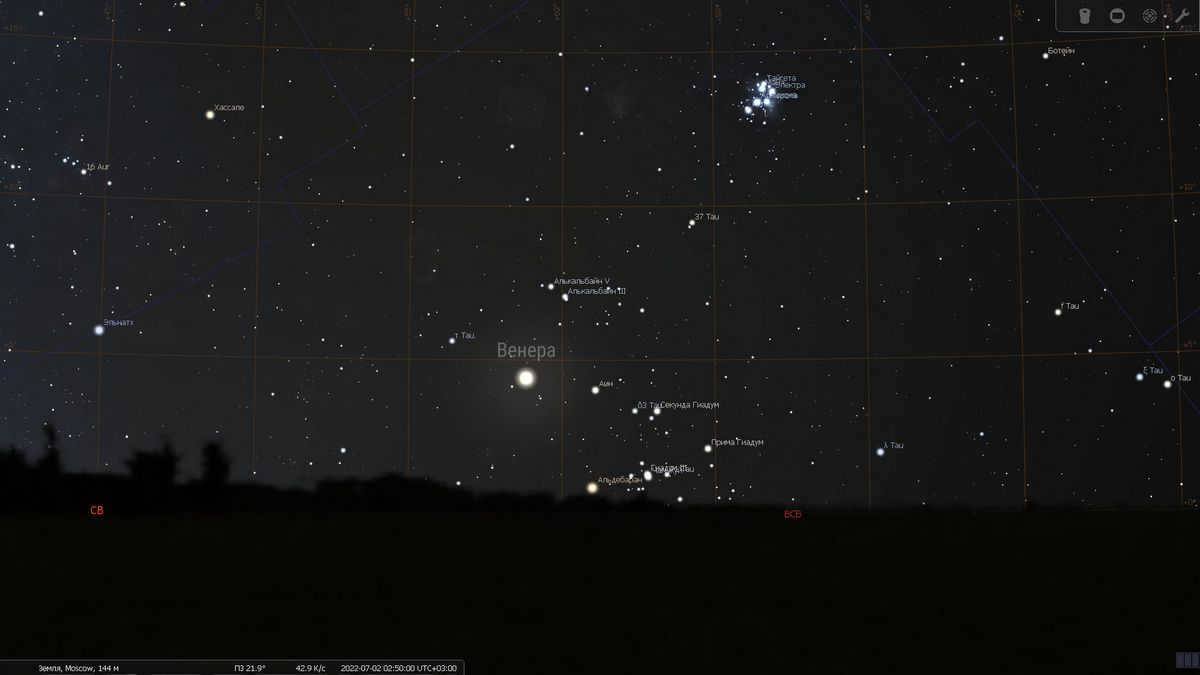
On July 2, 2022, Venus will make a close pass by the star Aldebaran and the Hyades star cluster in the constellation Taurus
On July 26, we will witness the penultimate conjunction of Venus and the Moon, as both celestial bodies will be located in the constellation Gemini, about 20 degrees away from the Sun.
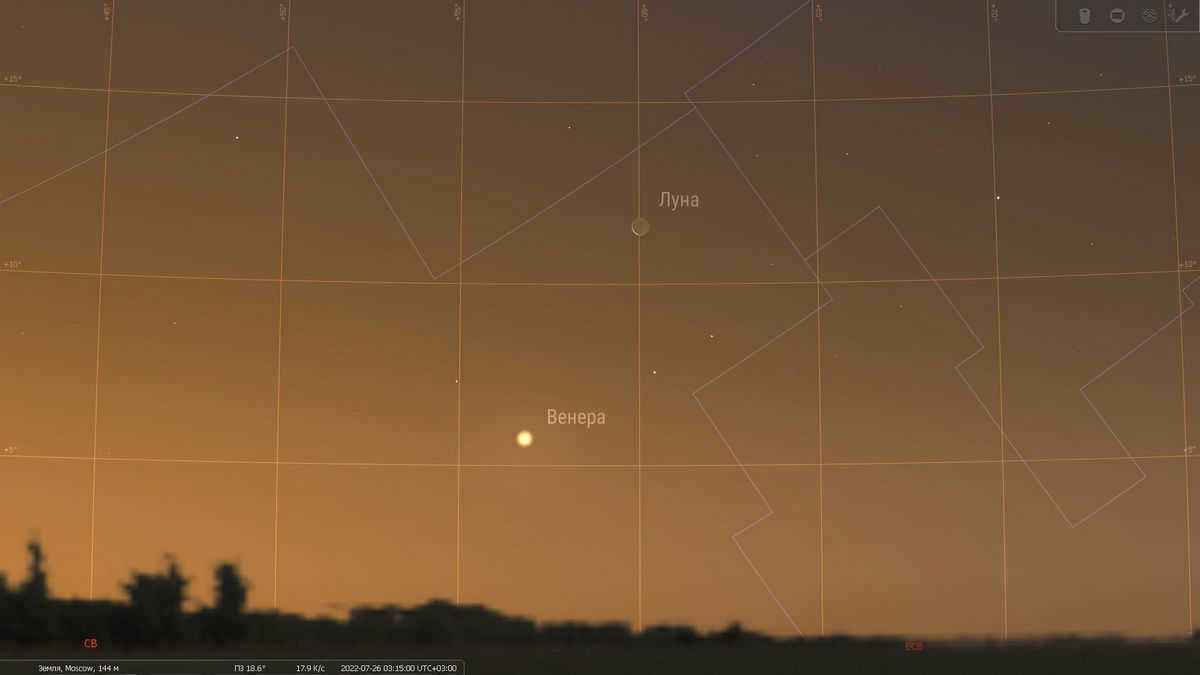
On July 26, 2022, the Moon will be in close proximity to Venus.
As we move past the summer solstice, the Sun’s declination gradually decreases, causing it to rise later each day. This allows Venus to be visible for longer periods of time during the morning twilight. It almost appears as though Venus is seeking retribution for the months of spring when its visibility was minimal. However, as Venus draws nearer to the Sun, this illusion is shattered, and its radiance fades with the arrival of daylight.
On the 26th of August, the Moon and Venus will once again cross paths at the boundary between Cancer and Leo. The Moon’s crescent shape will be incredibly slim and hard to detect amidst the luminous morning heavens. However, seasoned stargazers will find this to be an incredibly gratifying task.
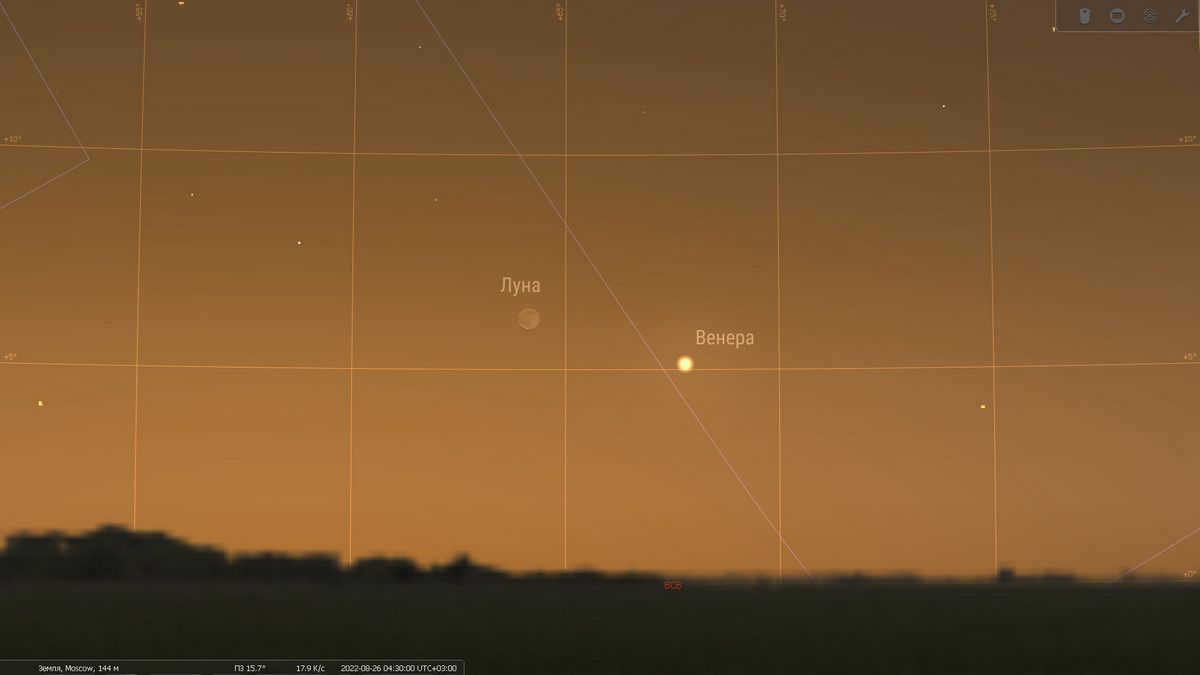
On August 26, 2022, there was a close encounter between the Moon and Venus.
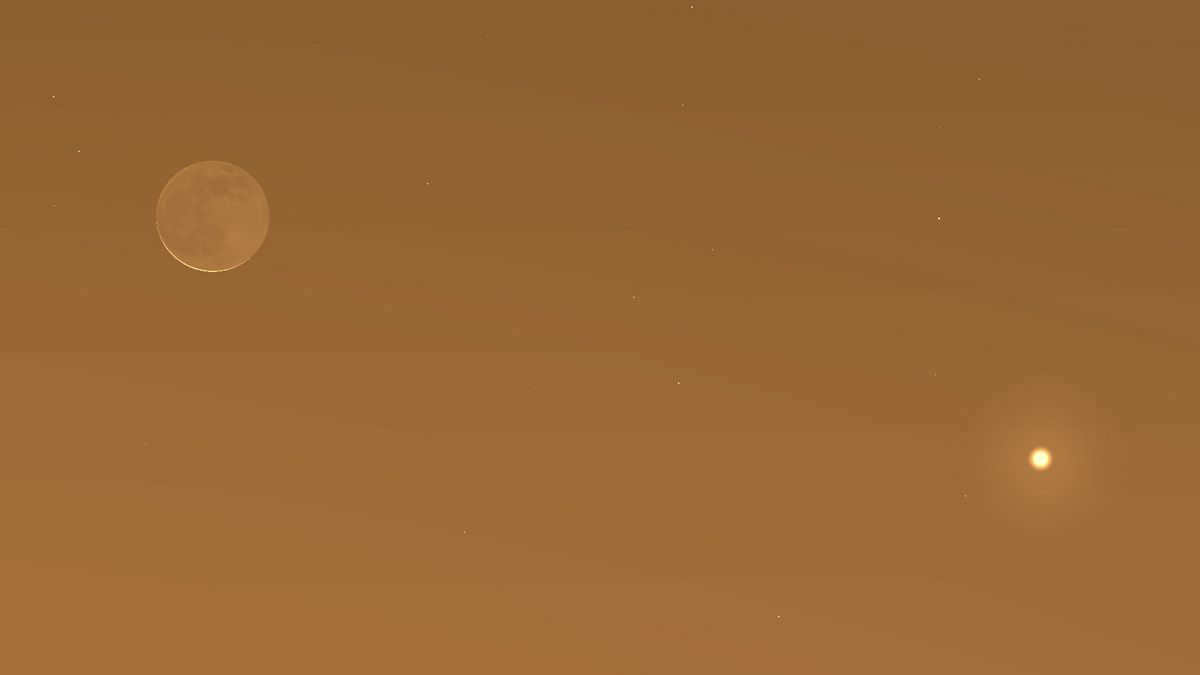
On August 26, 2022, there will be an interesting celestial event to witness – the Moon will be in close proximity to Venus. This will provide a stunning view, especially when observed up close.
September 2022
In September 2022, there is another noteworthy event to look out for. Venus will have a conjunction with the star Regulus (alpha Leo) on the morning of September 5. The distance between Venus and Regulus will be less than 1 degree, making it a remarkable sight. It’s worth noting that Venus will appear 100 times brighter than the star Regulus.
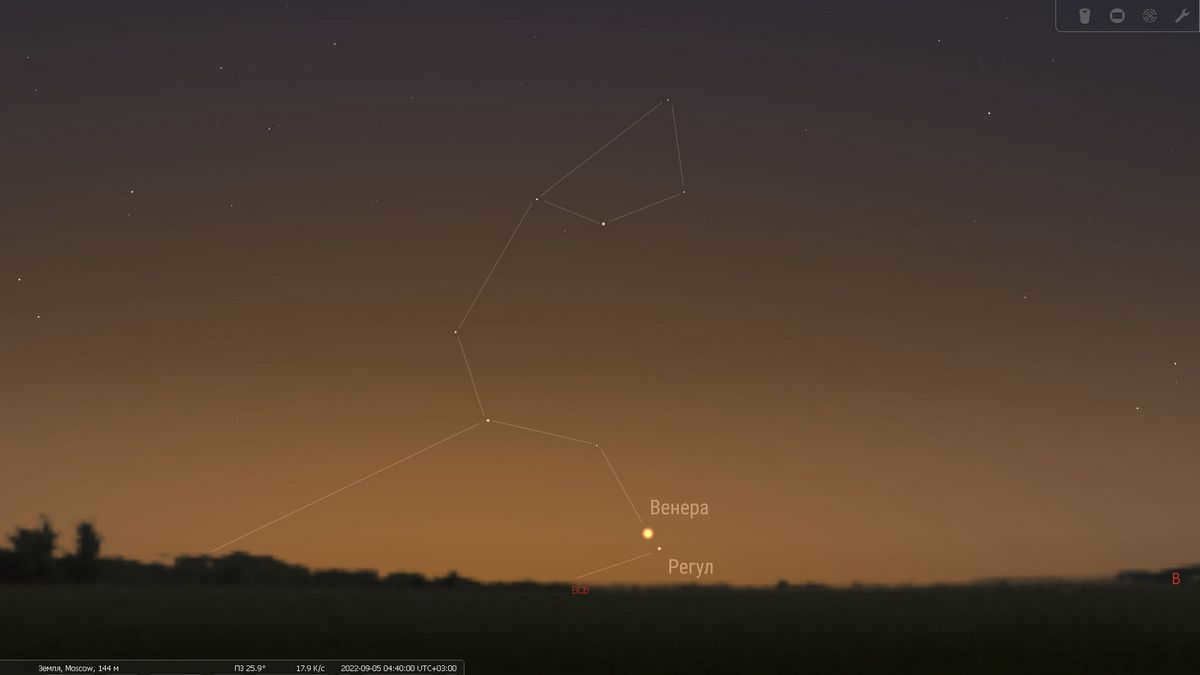
On September 5, 2022, Venus will be in close proximity to the star Regulus, which is the alpha star of the Leo constellation.
Towards the end of September, the visibility of Venus in the morning sky will come to an end in the southern latitudes. On October 23, Venus will reach its upper conjunction with the Sun. This means that from the perspective of an observer on Earth, Venus will be positioned directly behind the Sun. During this time, the distance between Earth and Venus will be at its maximum, reaching 257 million kilometers.
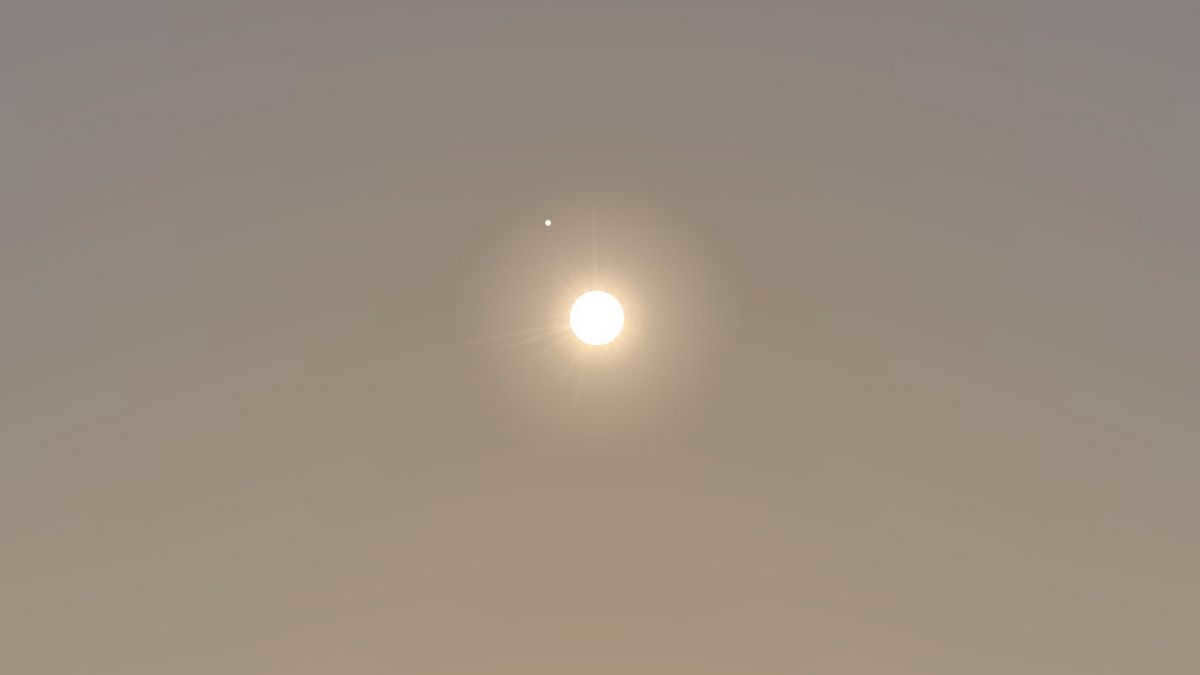
October 23, 2022. The Sun and Venus are aligned in an upper conjunction.
Musical Addition
Attached to this article is a beta version of a new composition titled “Eosforos.” The name of the composition is derived from the ancient Greek term for the morning or evening star, which is now known as the planet Venus.
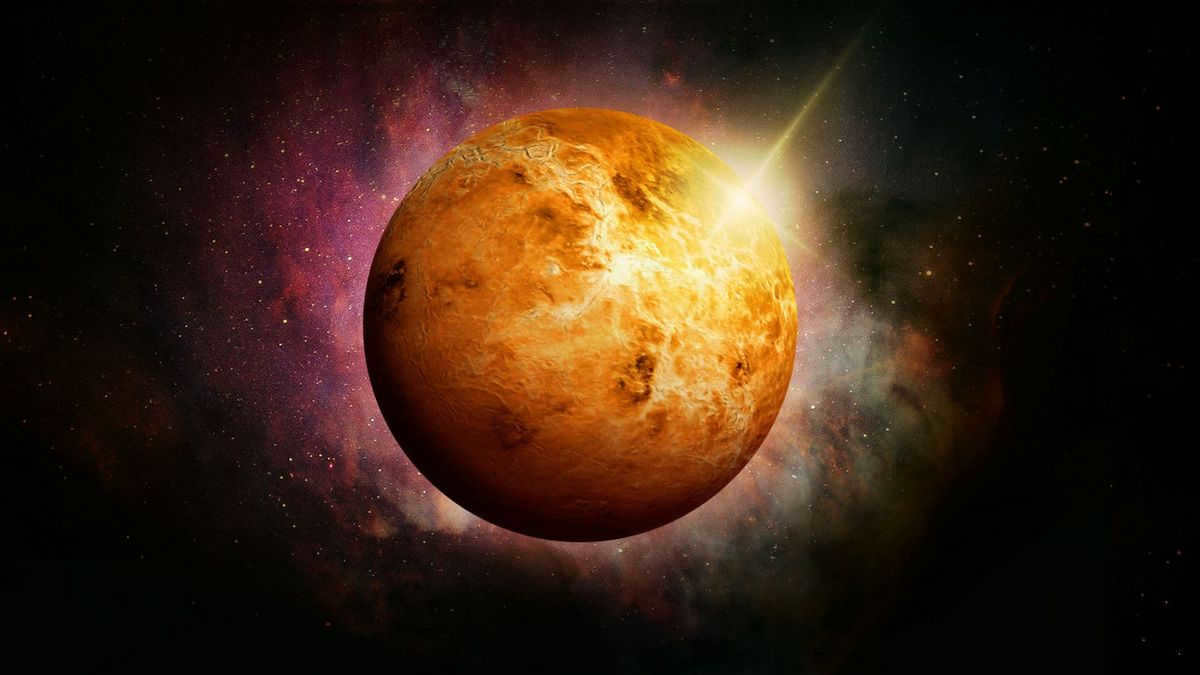

From July 8 to July 11, 2020, skywatchers will be treated to a spectacular sight as Venus reaches its maximum brightness and appears dazzlingly near the star Aldebaran and the Pleiades star cluster. Keep reading to discover the best way to observe this celestial event and what you can expect to see.
Venus achieves peak brightness
On July 8, 2020, at 11:51 UTC or 14:51 MSC, Venus attains the midpoint of the maximum brightness period for morning visibility in 2020. The planet will emit a brilliant light in the sky with a stellar magnitude of -4.5. Stellar magnitude is a logarithmic scale employed by astronomers to classify objects based on their brightness, with low values indicating bright objects and negative values indicating exceptionally bright objects.
The brightness of Venus is determined by its distance from Earth and its phase. Venus reaches its maximum brightness when less than half of its surface is illuminated, as it is closest to Earth during its crescent phase.
To determine the precise time to observe celestial objects in your area, you can utilize the Star Walk 2 stargazing app. Don’t forget to enable notifications so you don’t miss out on the most captivating astronomical events.
Light of the Morning Star
Venus appears alongside Aldebaran and the Pleiades
During the month of July and early August, Venus will be passing through the Taurus constellation. On July 11, 2020, in the morning sky, Venus will be positioned to the upper left of the prominent star Aldebaran, known as the fiery eye of the mythical bull. Venus will be shining with remarkable brightness before dawn, making it a perfect opportunity to use binoculars to locate Aldebaran in the sky, as the approaching rays of daylight may make it difficult to see. While Aldebaran is a first magnitude star, it still pales in comparison to Venus, which is 100 times brighter than any other star in the Taurus constellation.
The Pleiades, a cluster of stars located in the northwestern part of the Taurus constellation, will be visible in the night sky alongside Venus and Aldebaran during these upcoming days. Also known as the Seven Sisters, the Pleiades derived their name from the seven daughters of the titan Atlas and the oceanid Pleione. According to an ancient myth, the hunter Orion chased after the sisters, and in order to protect themselves, they pleaded with the gods for assistance. Zeus transformed them into stars within the Taurus constellation, while also punishing Orion by transforming him into a constellation as well, forever doomed to pursue the Pleiades without success until the end of time.
Keep up with our news updates to ensure you don’t miss out on the most fascinating astronomical events.
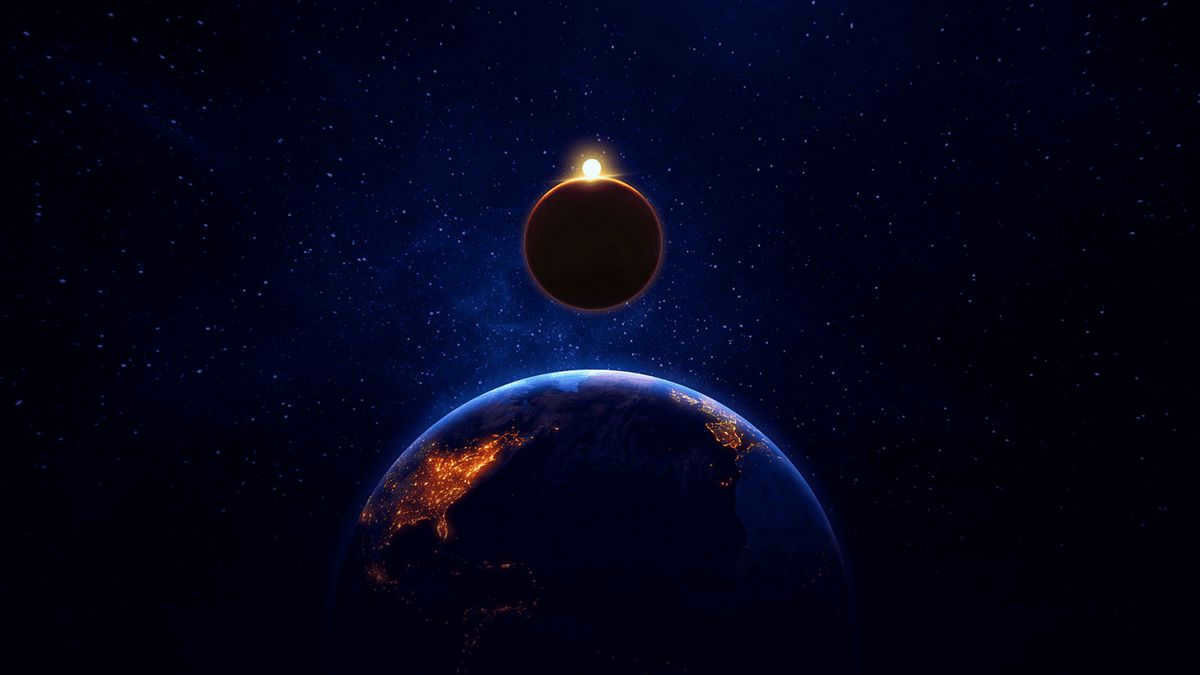
Venus is known as the second planet in our solar system, and it shines as the third most luminous celestial body in the heavens, only outshone by the Sun and the Moon. What causes Venus to be referred to as the morning or evening star? How can we locate Venus in the sky in the upcoming days? Let’s explore these questions.
“Evening star” or “morning star.”
Venus outshines all the other stars with its constant silvery glow, making it easily distinguishable. When Venus rises before the Sun, it is known as the “morning star,” and when it disappears below the horizon following the Sun, it is referred to as the “evening star.” Some early astronomers mistakenly believed that they were observing two separate celestial bodies. They named the morning star after Phosphorus, the bringer of light, and the evening star after Hesperus, the son of Atlas.
Ancient sky watchers noticed that Venus moved in relation to the fixed stars, leading them to realize that it was a “wandering star.” The Greek philosopher and mathematician Pythagoras was the first to understand that Phosphorus and Hesperus were actually the same object.
If we take into account the movement of Venus in relation to Earth, it demonstrates a distinct pattern of motion: every 8 years, the positions of Venus, the Sun, Earth, and the stars align in the same way. In the span of 8 Earth orbits around the Sun, Venus completes 13 orbits around the Sun, creating an elegant curve around Earth. This curve is known as the Venusian pentagram, as it consists of 5 “petals”, representing the moments when Venus is closest to Earth (Venus’ perigee).
Lower Conjunction of Venus
On June 3, 2020, the Earth will witness a rare celestial event known as the lower conjunction of Venus. During this phenomenon, Venus will align itself between the Earth and the Sun. It is an occurrence that takes place five times within each cycle of Venus and almost coincides with perigee. This time, Venus will pass extremely close to the Sun, appearing just 0°29' above it when observed from Earth.
Typically, when Venus aligns with the Sun in a lower conjunction, it either passes above or below the Sun’s disk in the sky due to the inclination of its orbit in relation to Earth’s orbit. However, there are exceptional instances when Venus directly crosses in front of the Sun. This extraordinary phenomenon is called a transit of Venus. The most recent observable transit took place in 2012, and the next one is not expected until 2117.
Venus Phases
The changes in light observed on the surface of Venus are known as the phases of Venus, which bear a resemblance to the phases of the Moon. It is widely accepted that the initial observations of the phases of Venus were conducted by Galileo Galilei in 1610.
When Venus is on the opposite side of the Sun from Earth, it presents itself as a full circle. However, its size is relatively small due to its farthest distance from us during this time. As Venus moves faster than Earth in its orbit around the Sun, it gradually approaches us, resulting in an apparent increase in size. When Venus reaches its farthest point from the Sun in the sky (maximum elongation), it appears as a quarter phase. Subsequently, before it passes between Earth and the Sun, Venus takes on the appearance of a thin crescent moon. Finally, Venus enters a new phase when it aligns directly with Earth and the Sun.
The complete cycle from new phase to full phase and back takes 584 days. This is the duration of one revolution of Venus around Earth.
“The elongation of Venus’ horns”
A significant phenomenon related to Venus is the stretching of its horns during the crescent phase near the lower conjunction, when the crescent’s arc measures more than 180 degrees. In some instances, when the angular distance between Venus and the Sun is extremely small, the elongated horns may even connect to form a complete ring, known as the “ring phase” of Venus.
This occurrence is a result of sunlight being scattered and refracted in the dense atmosphere of Venus.

